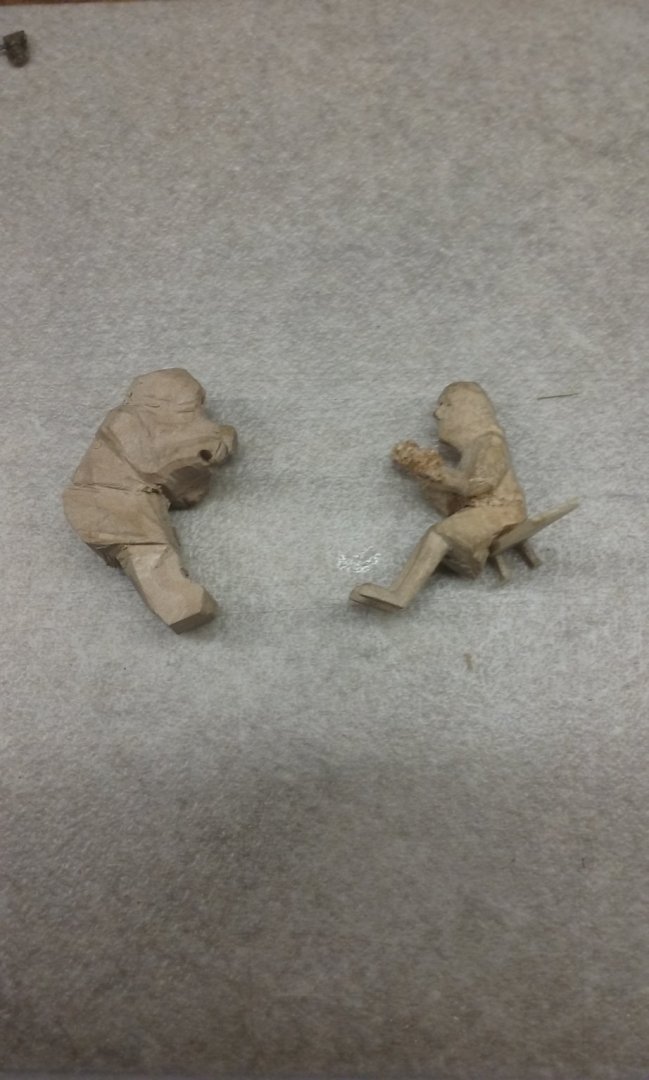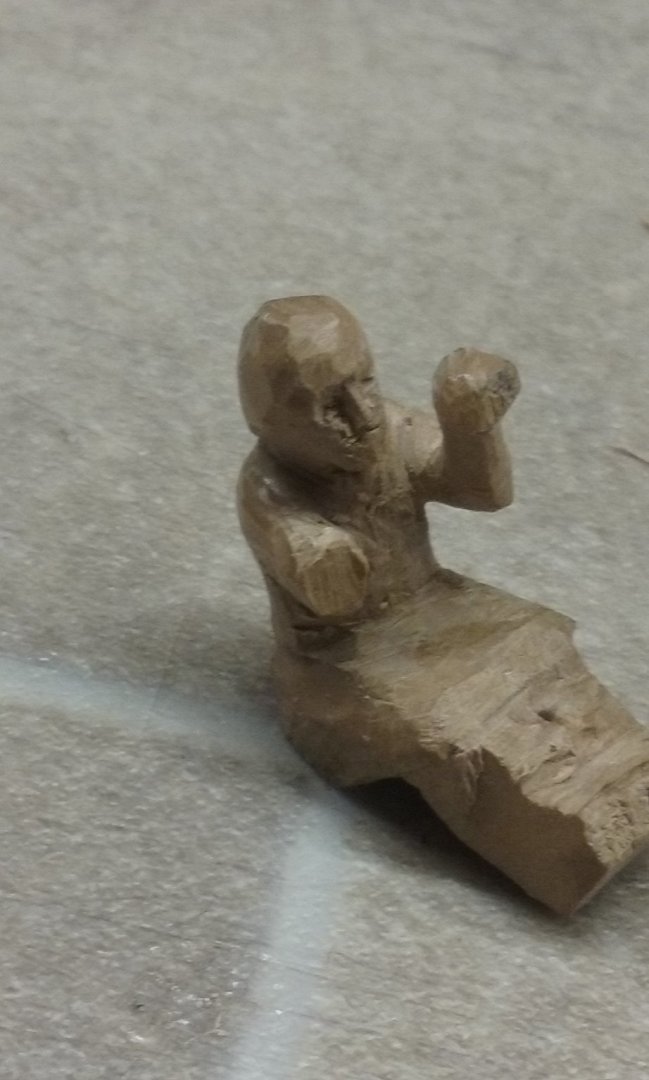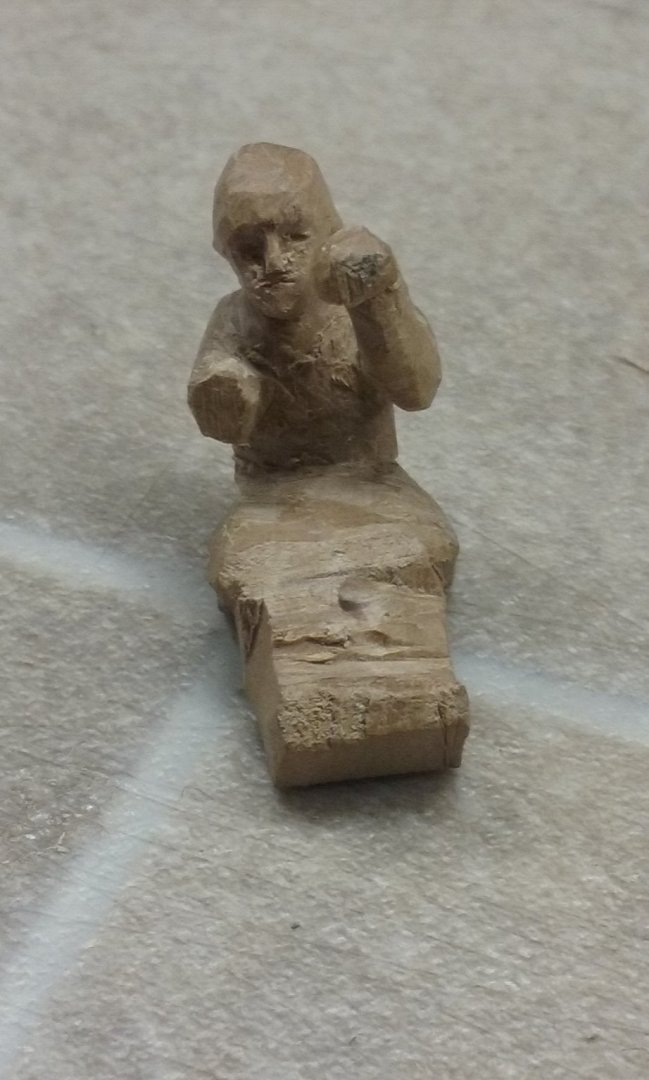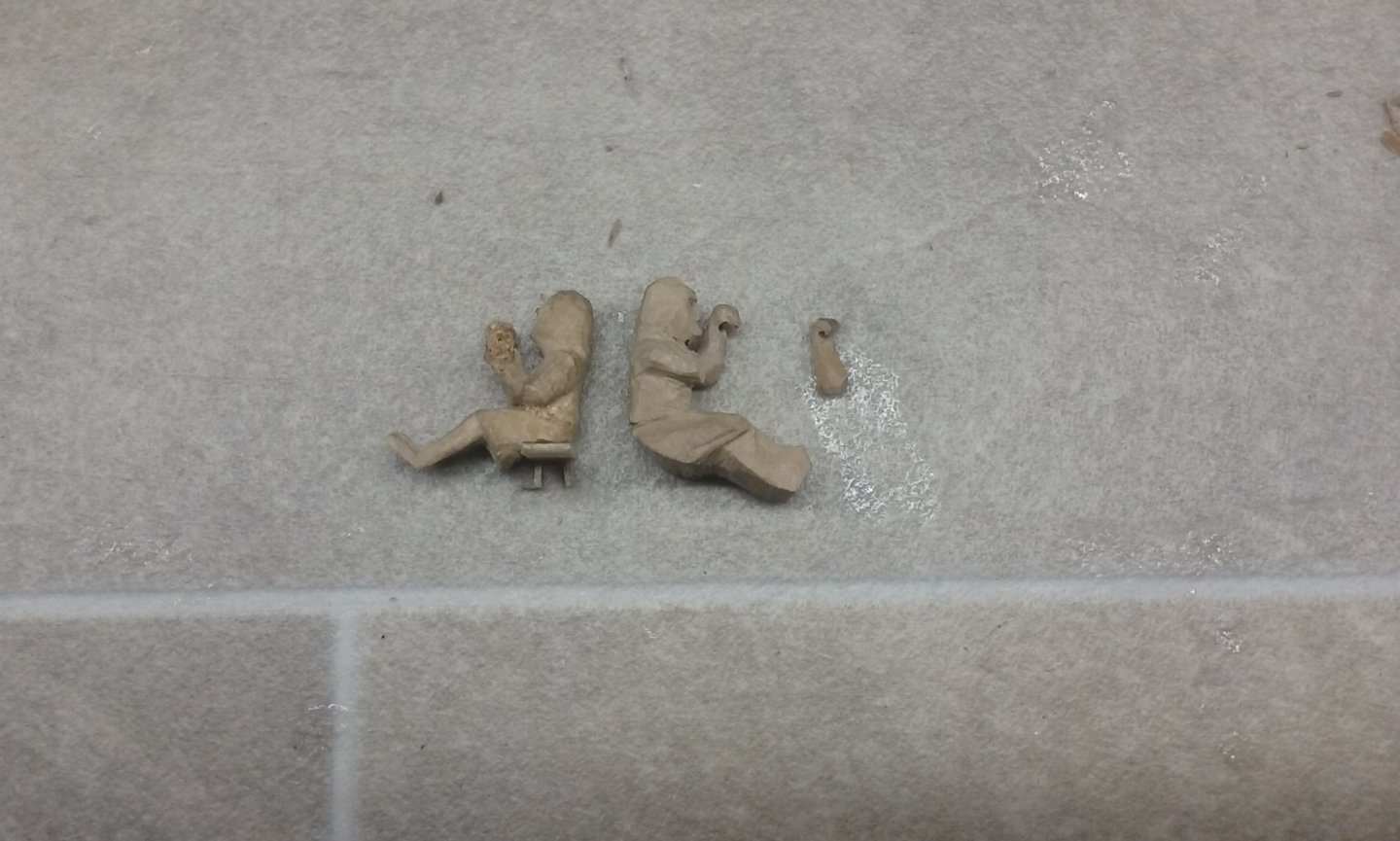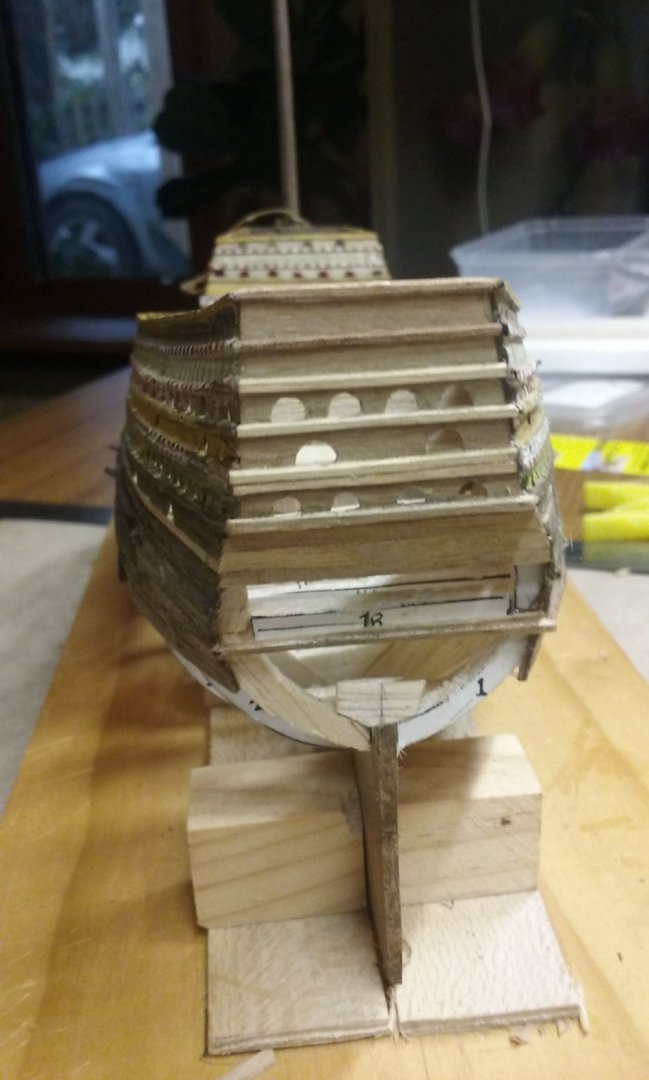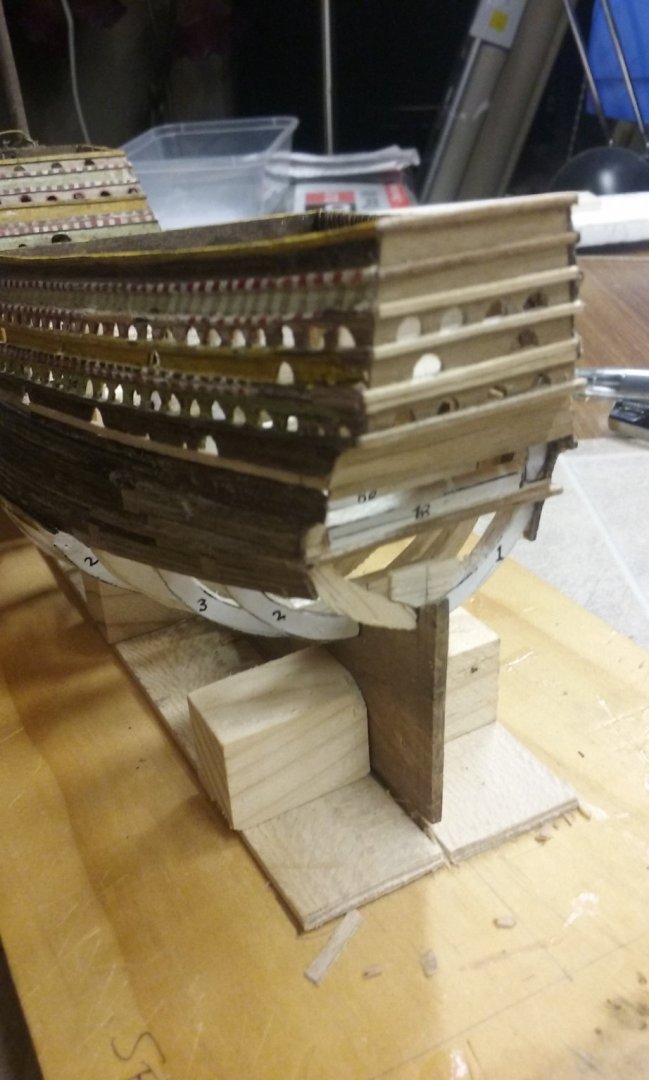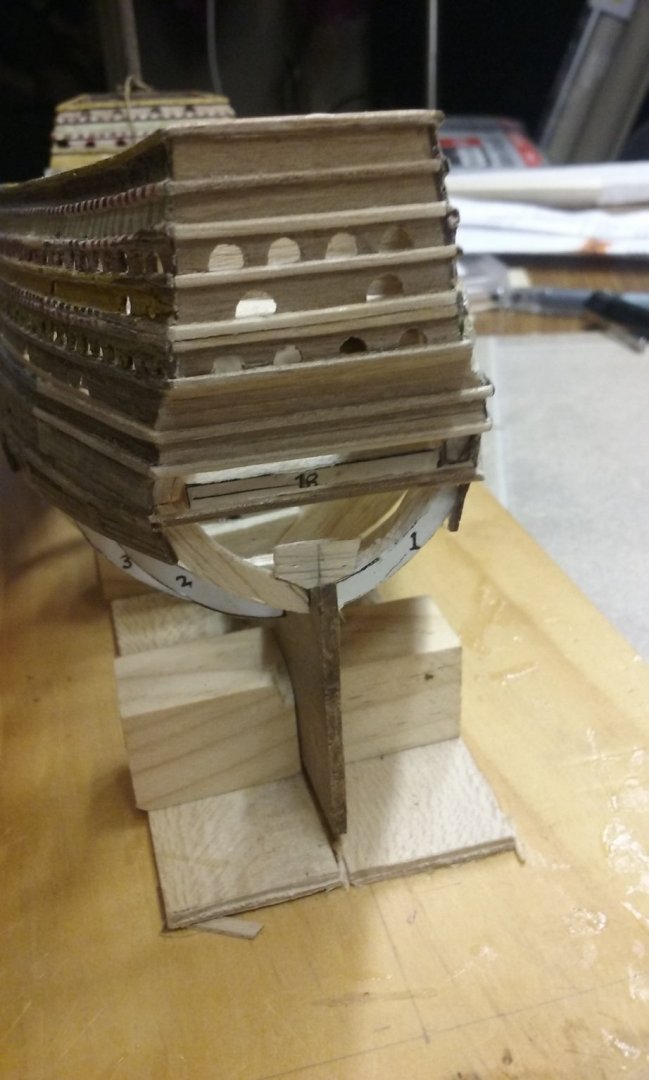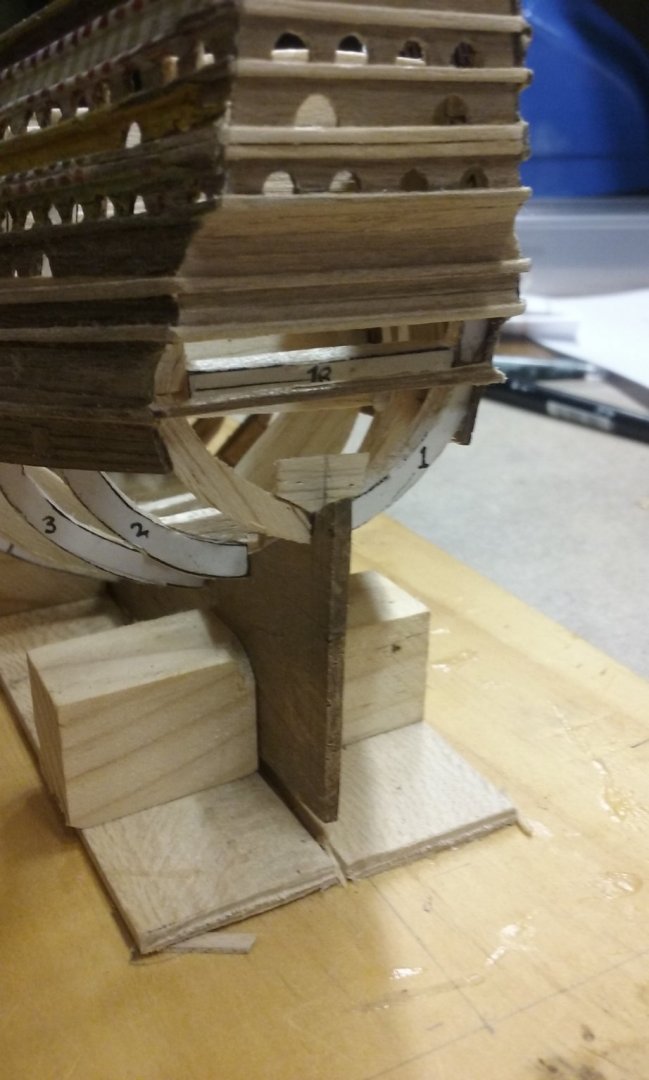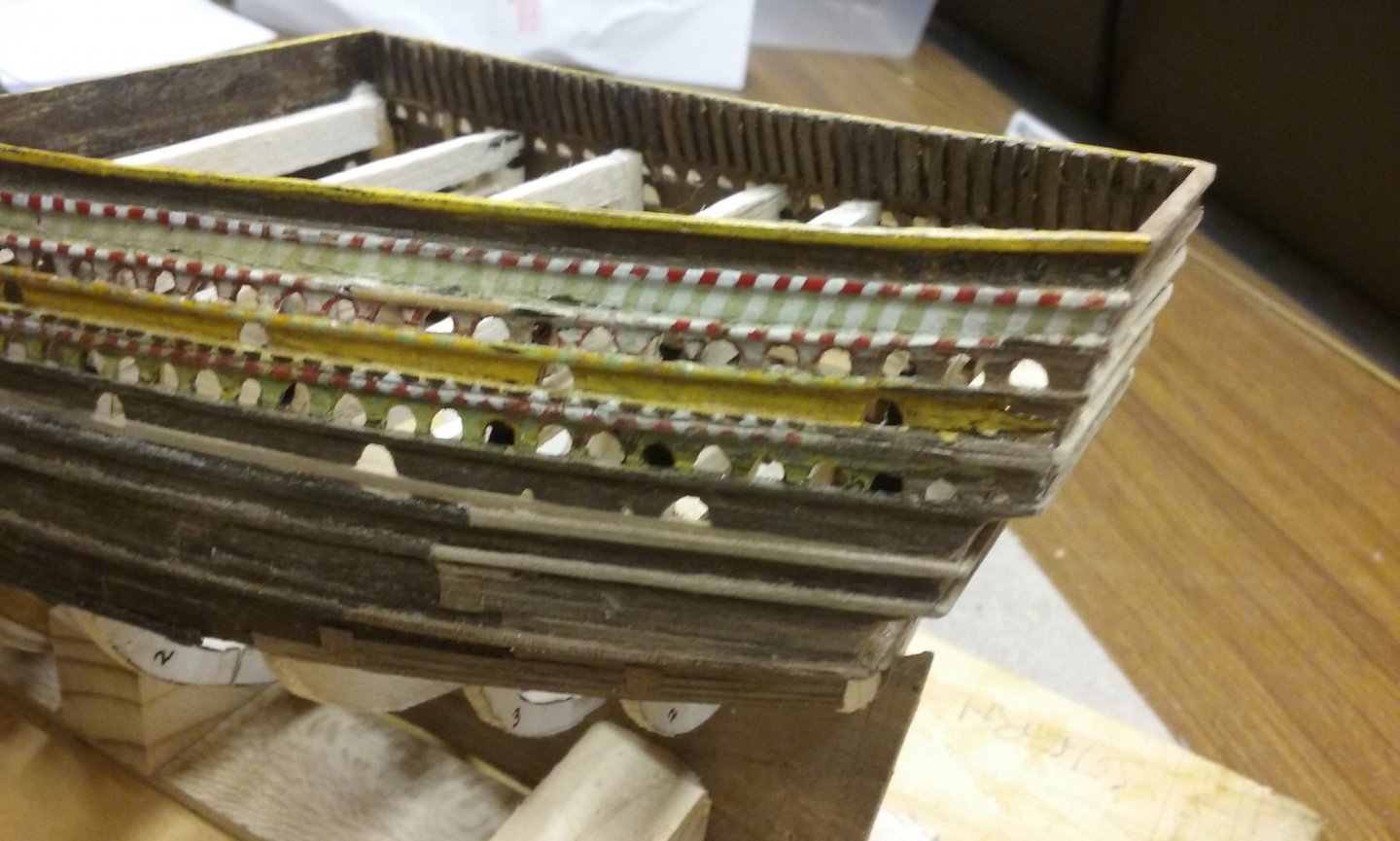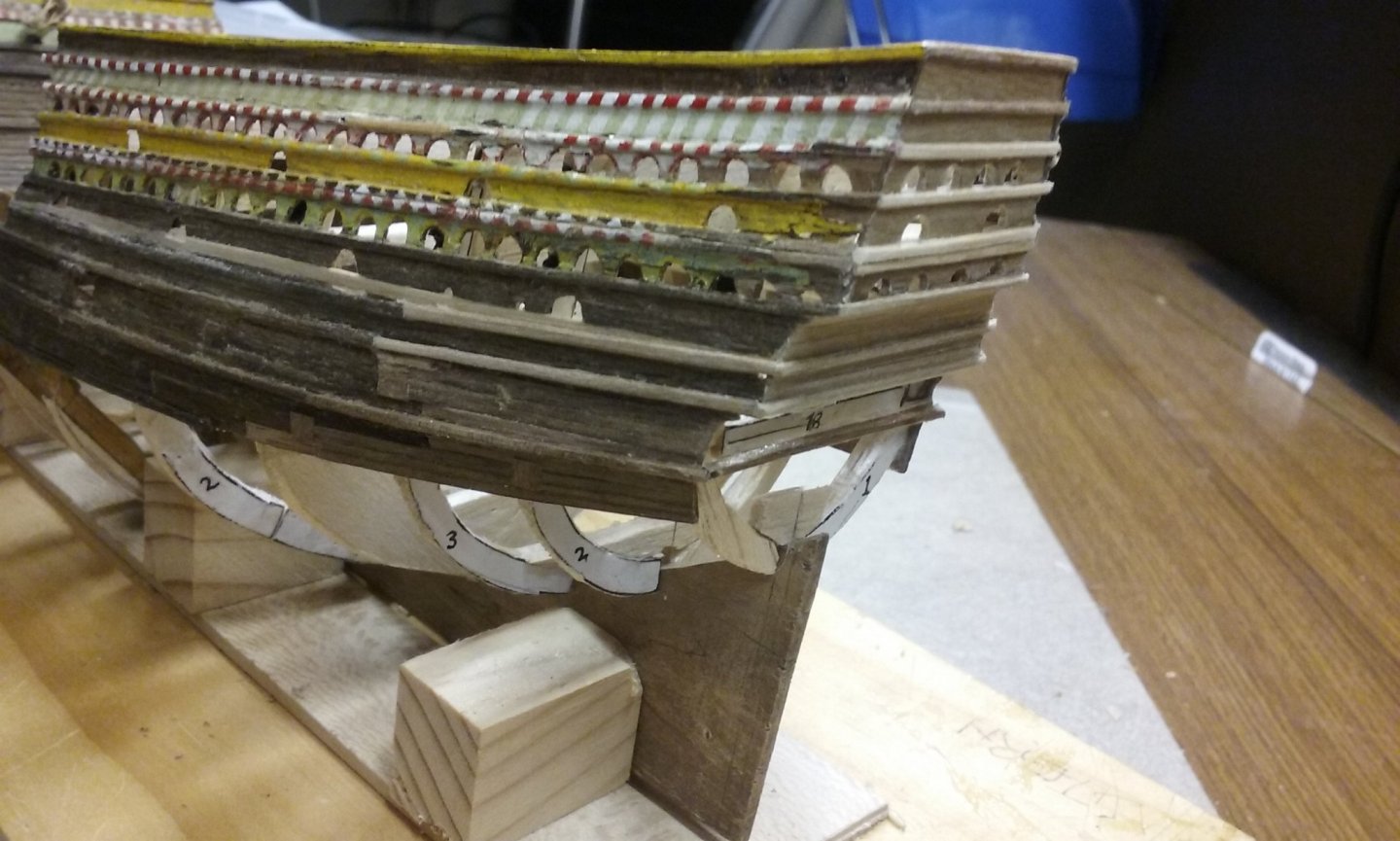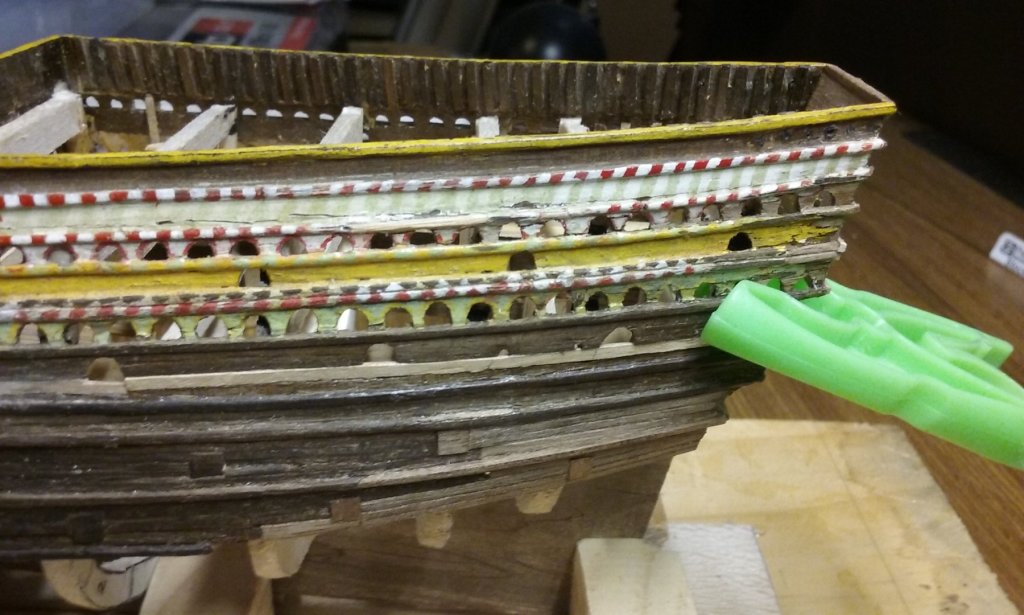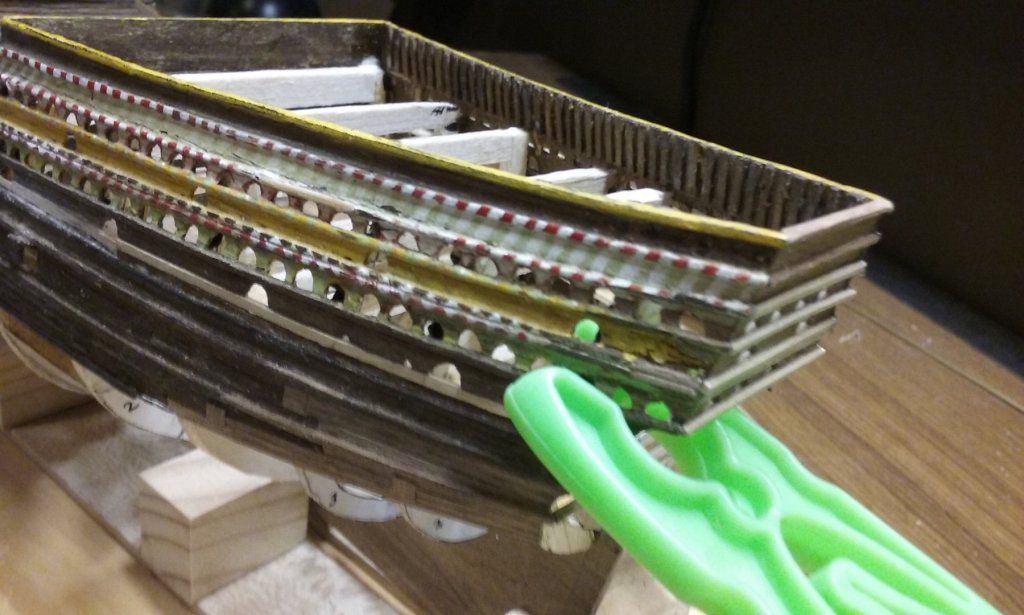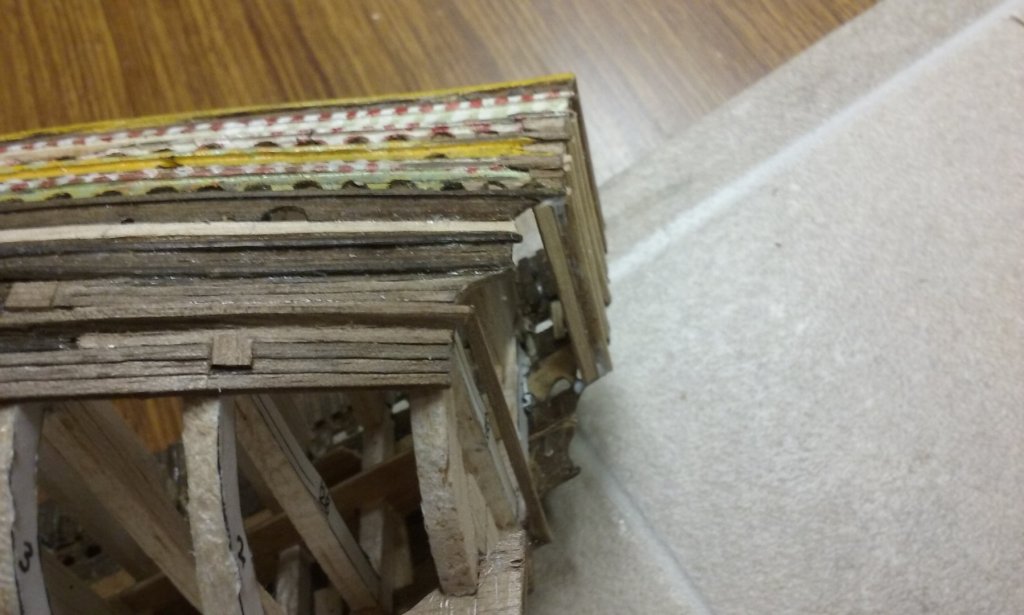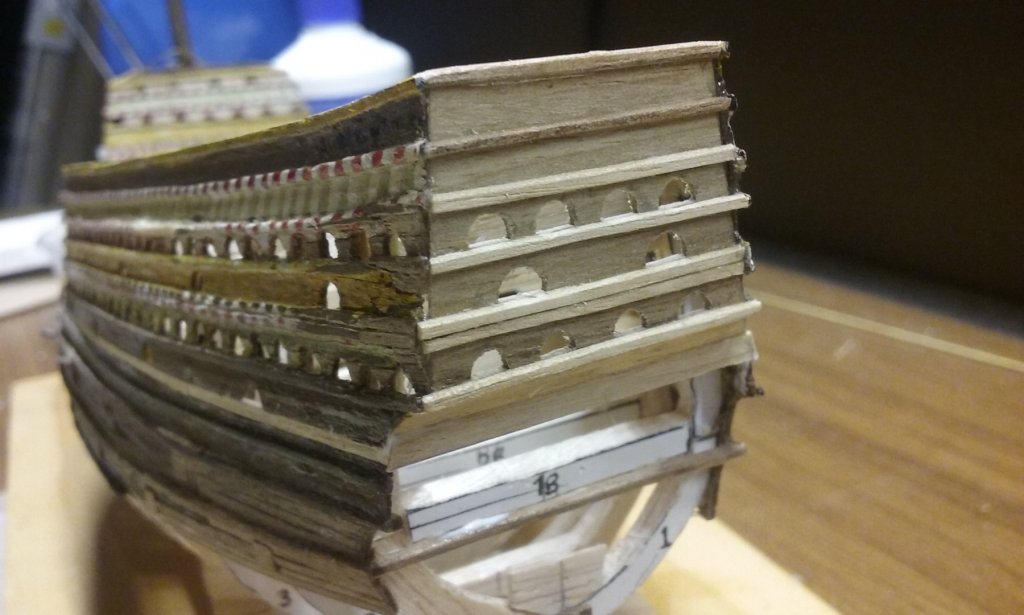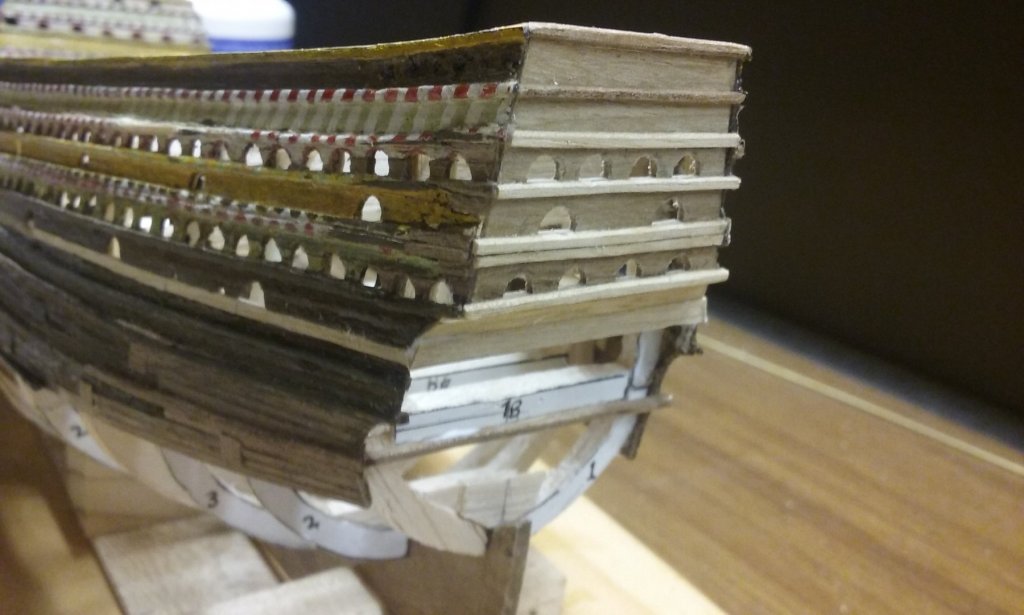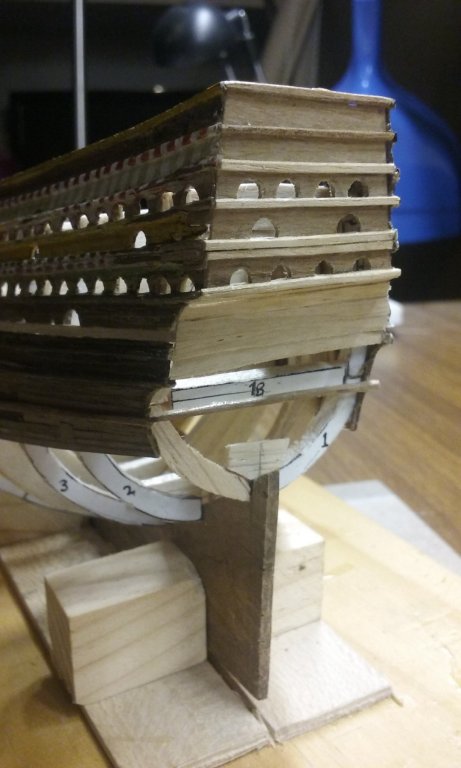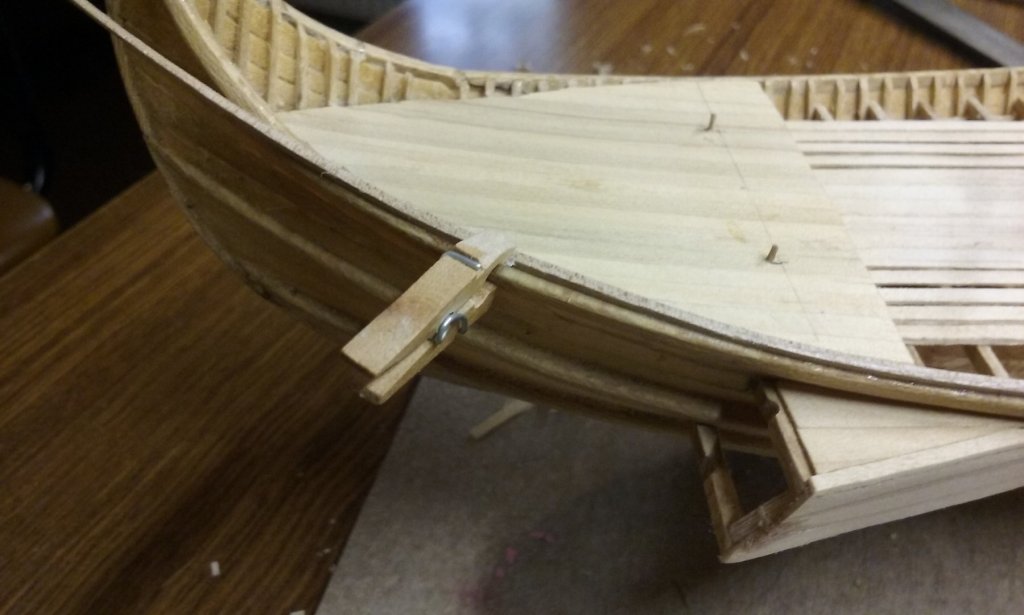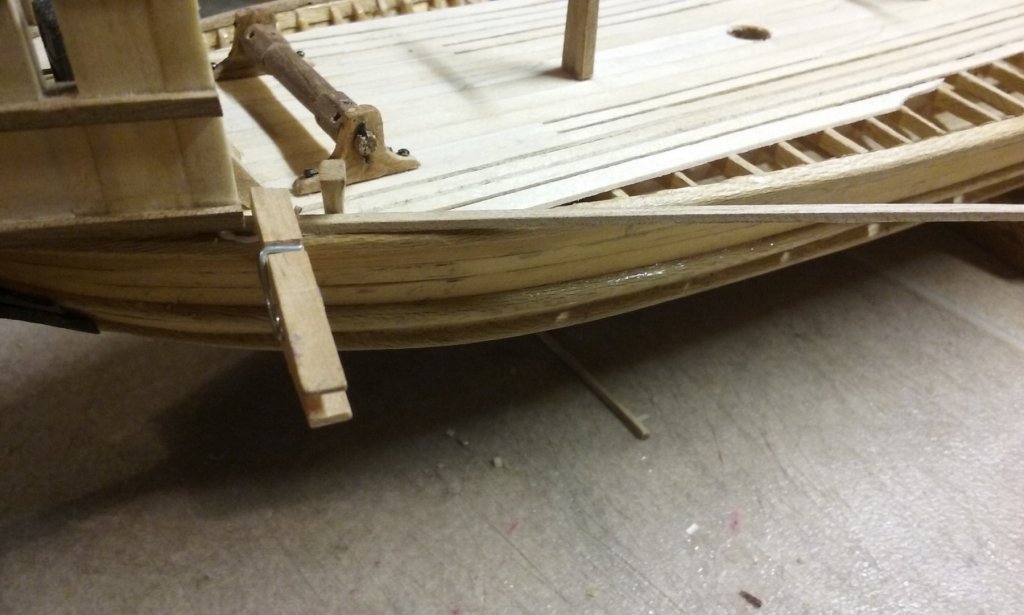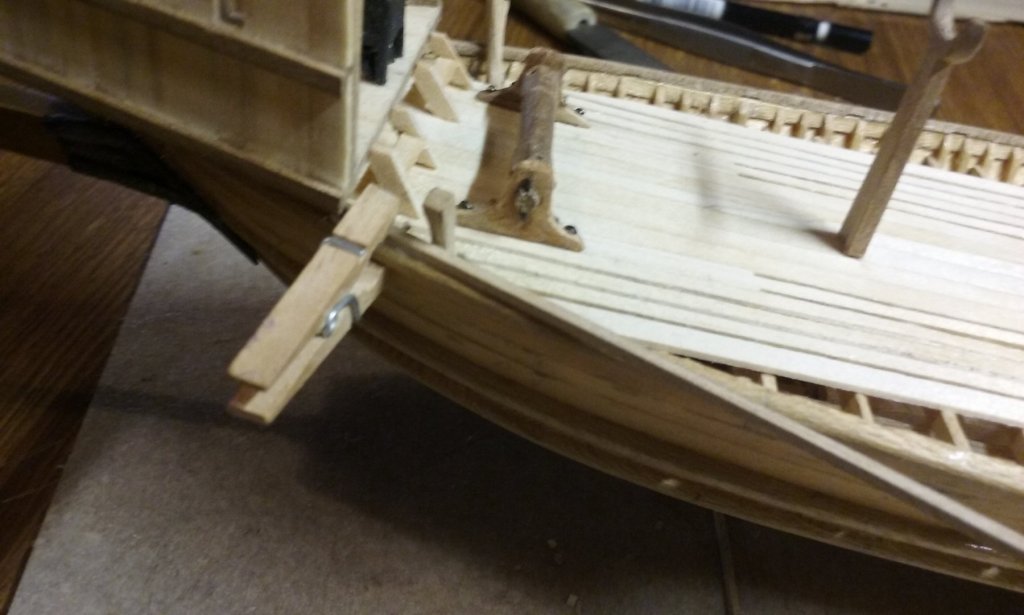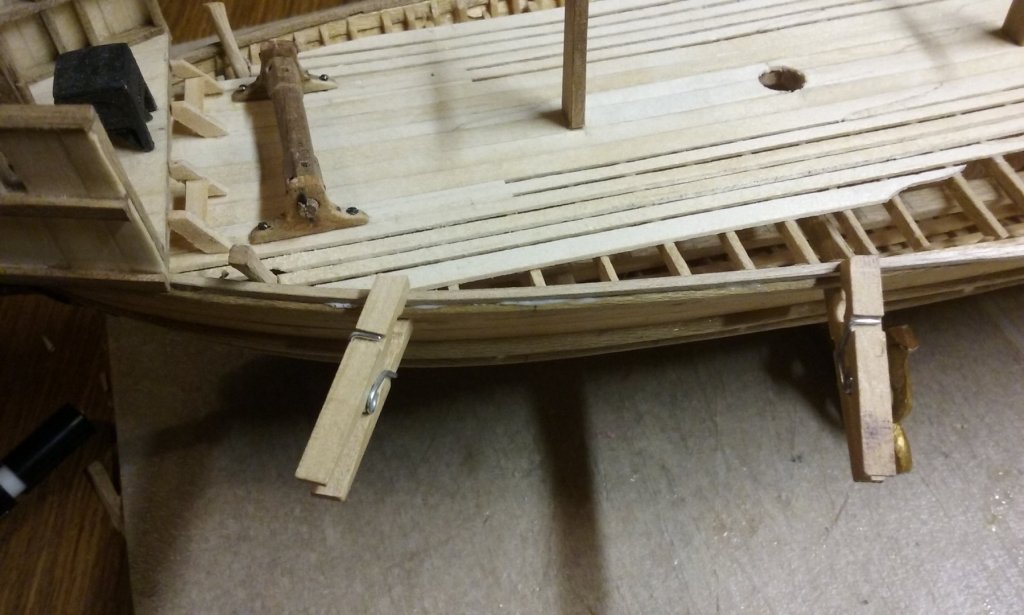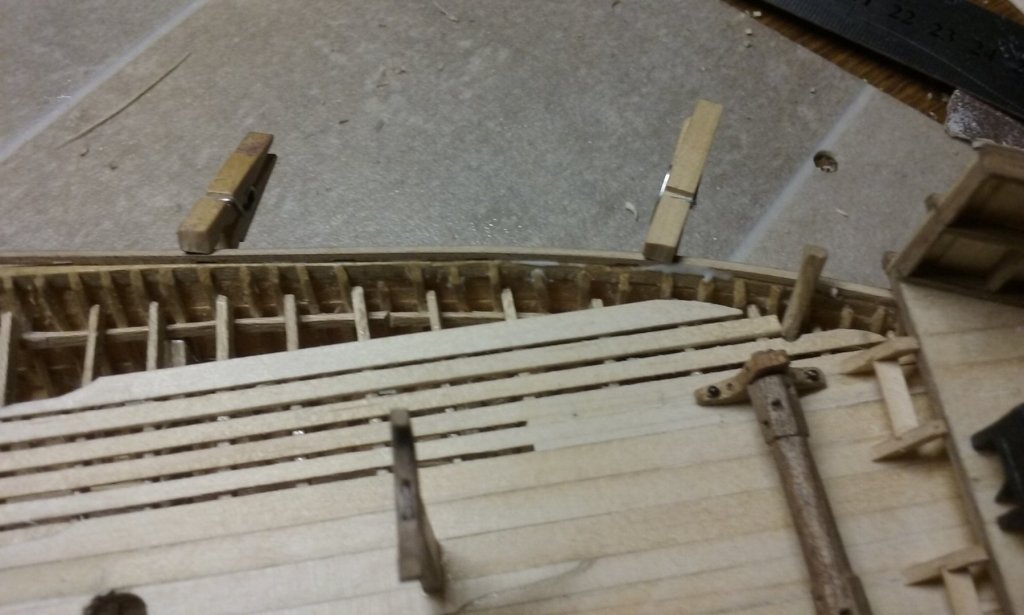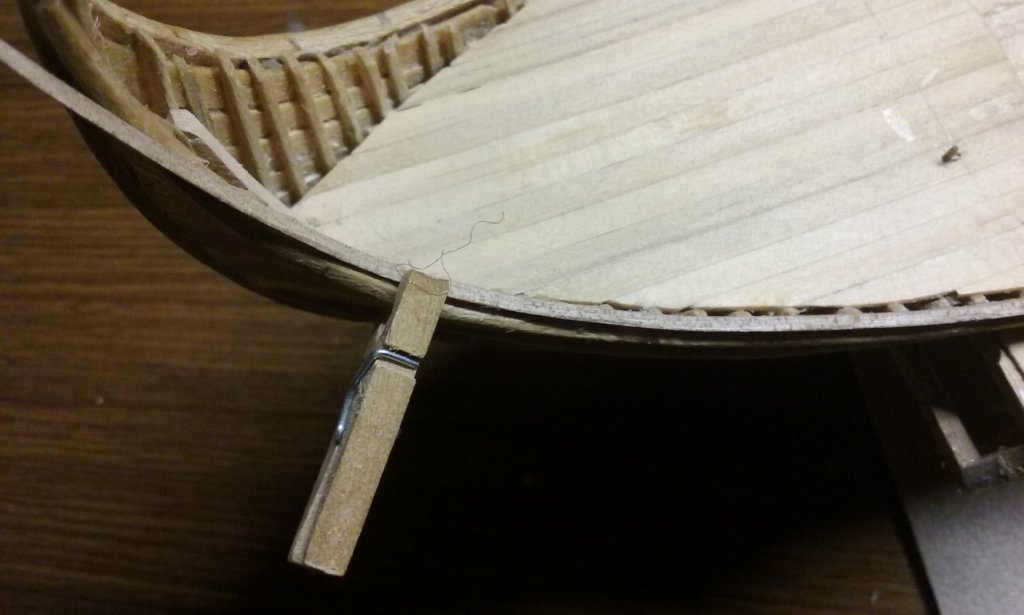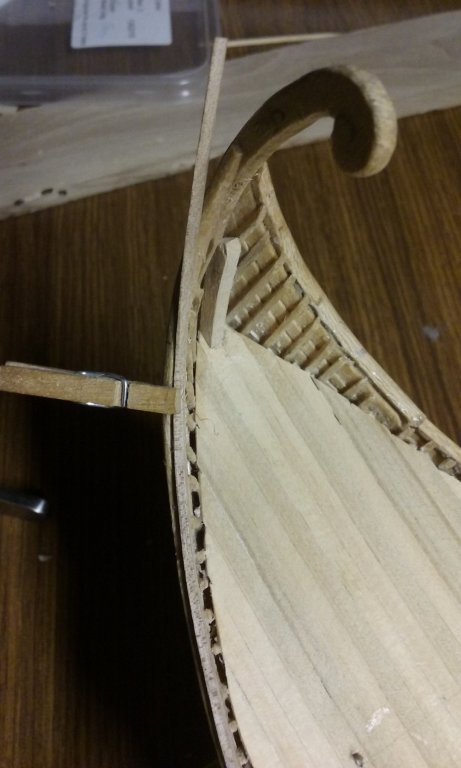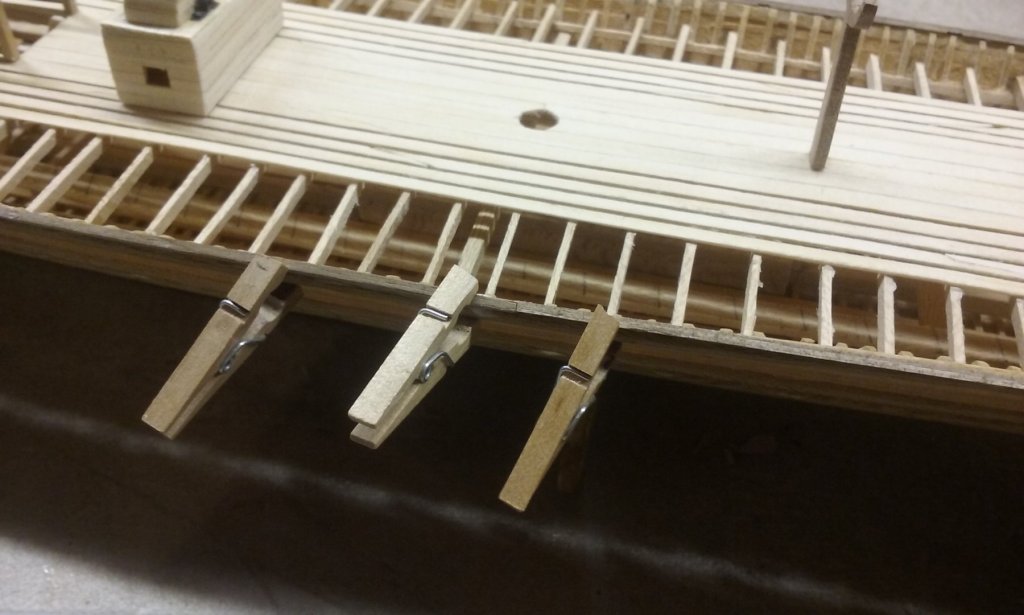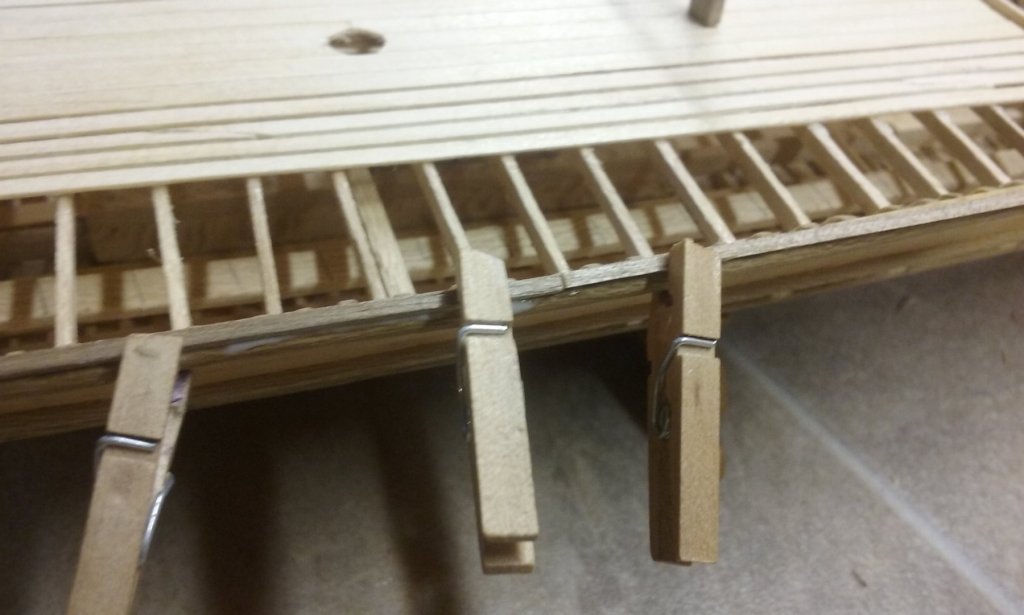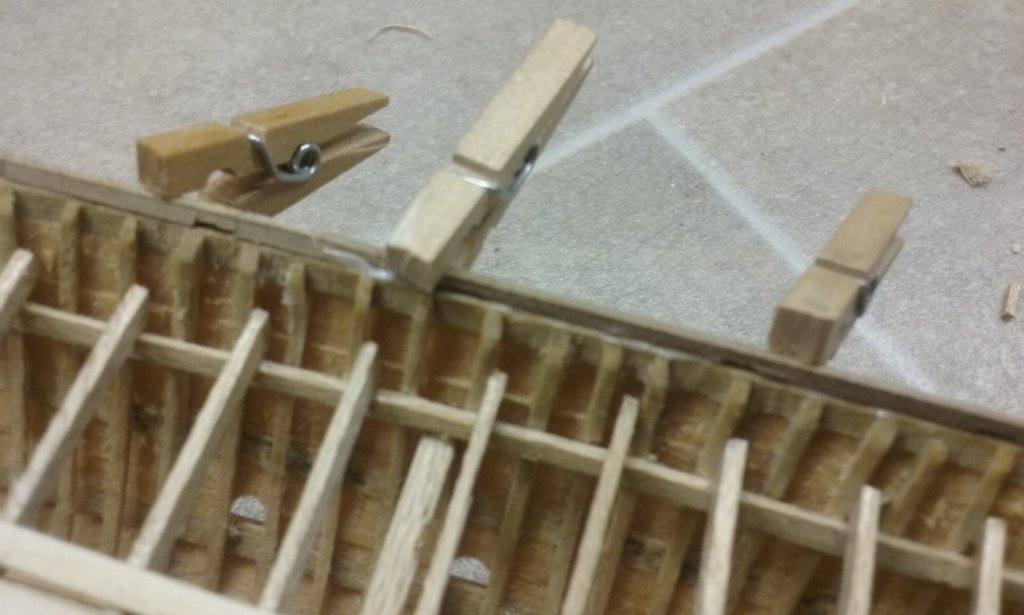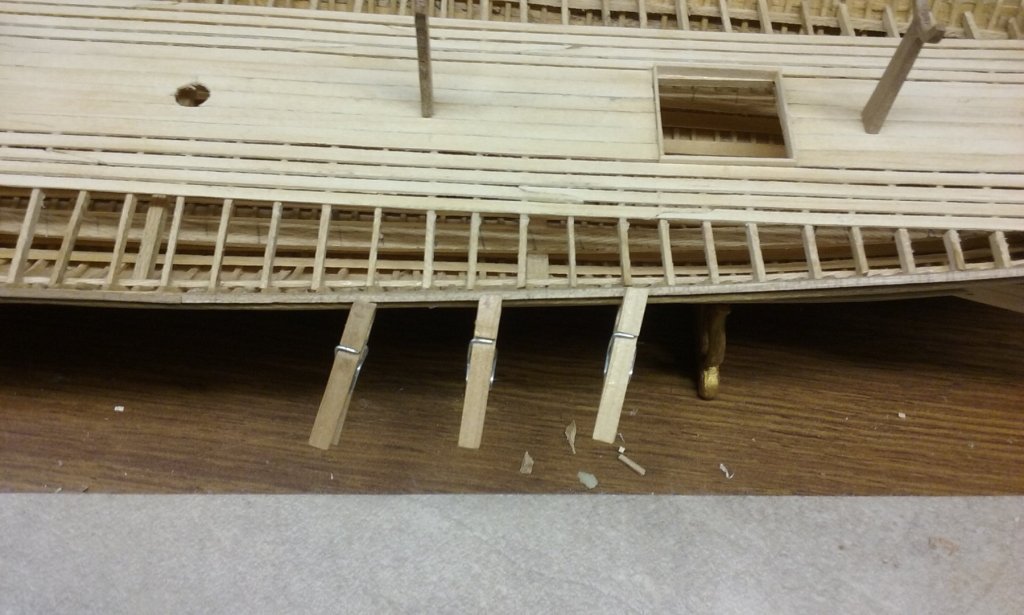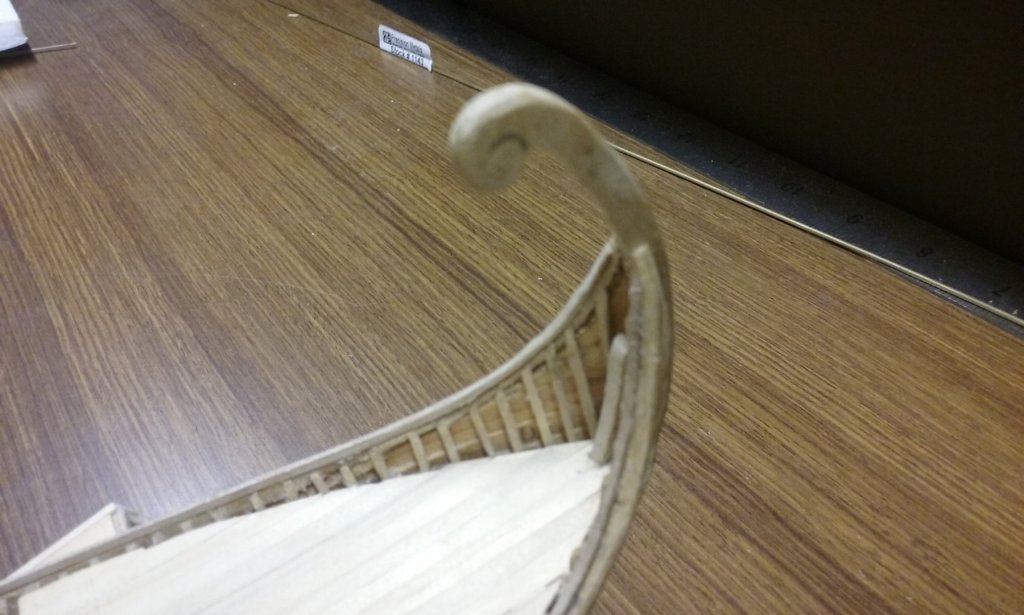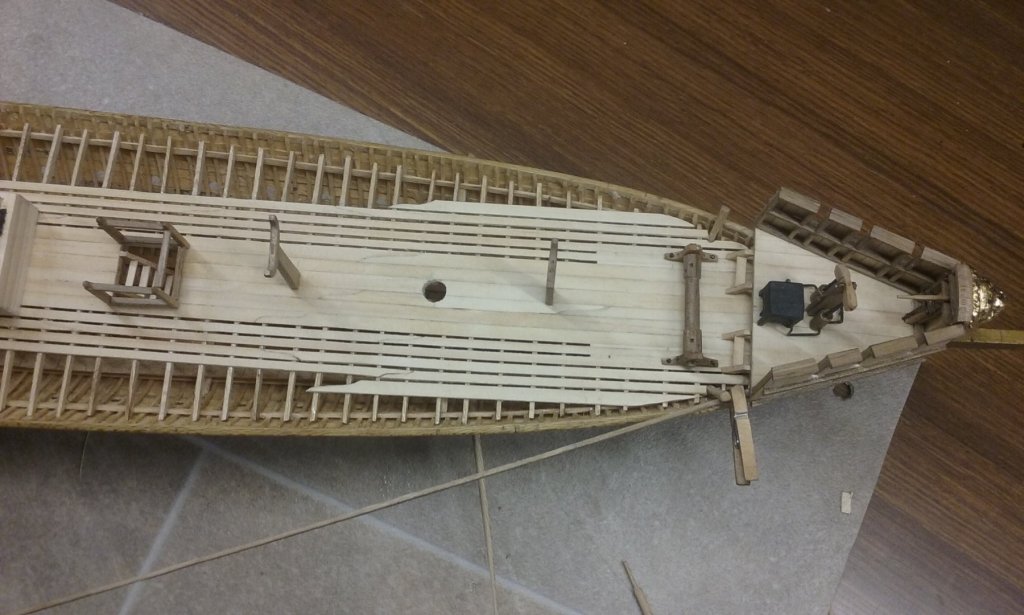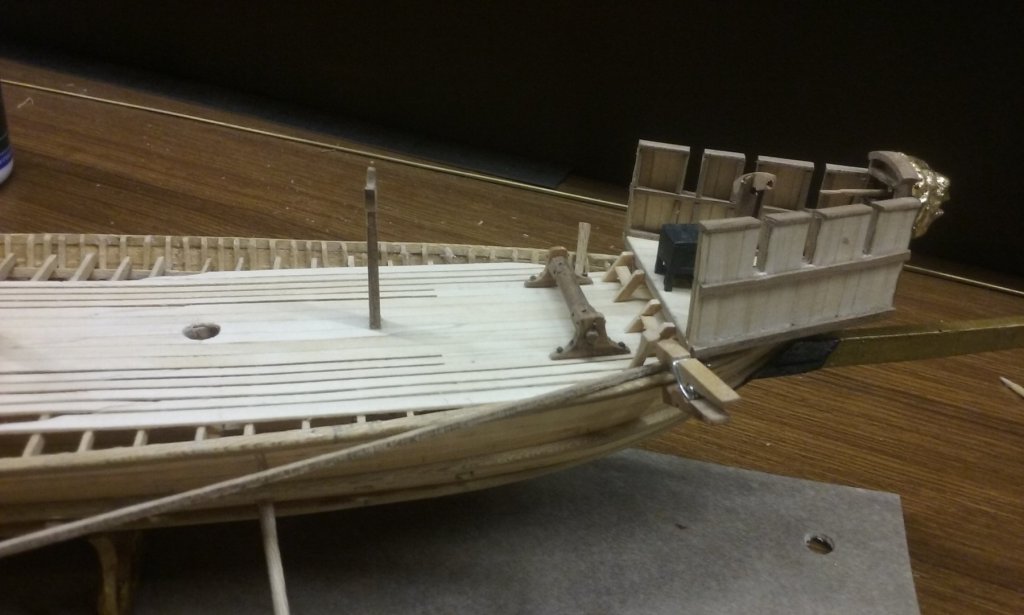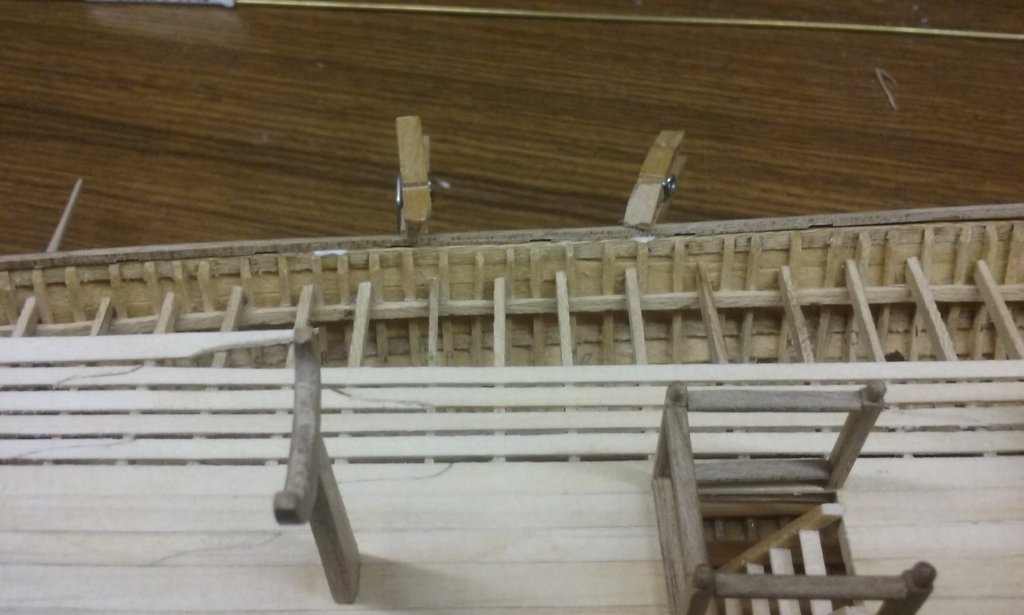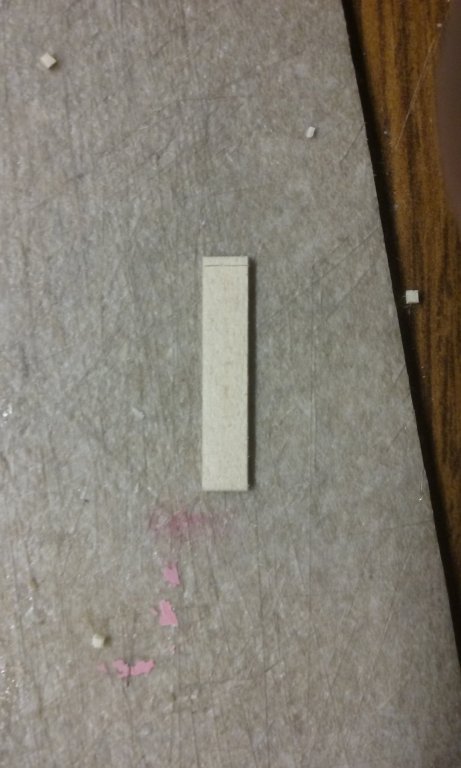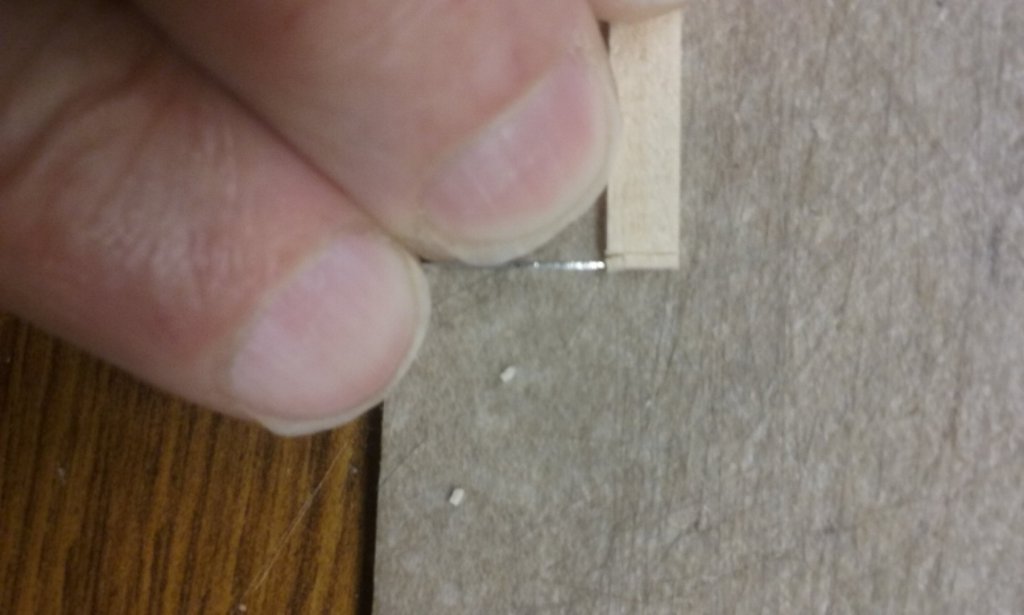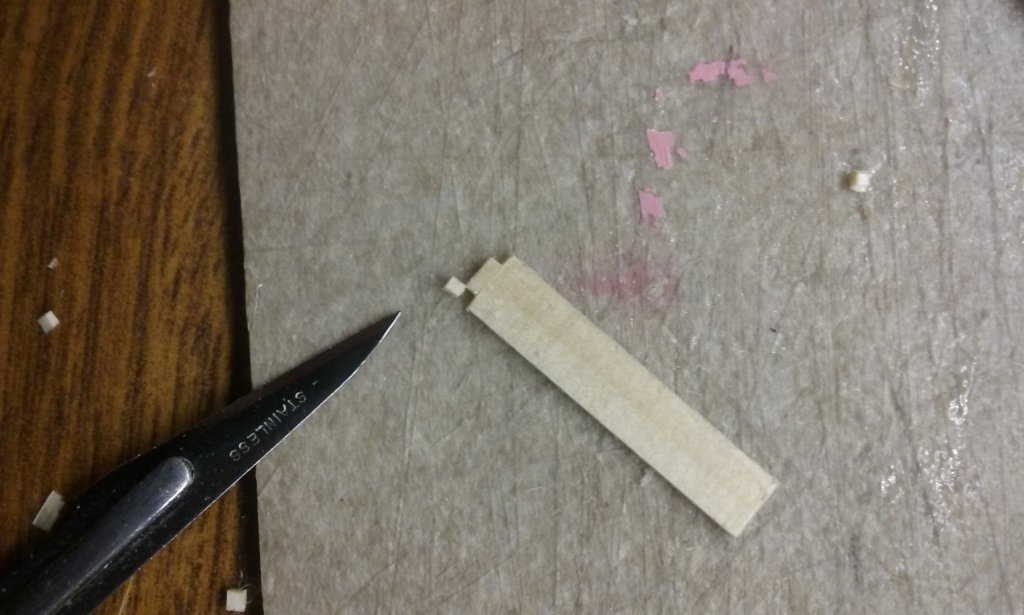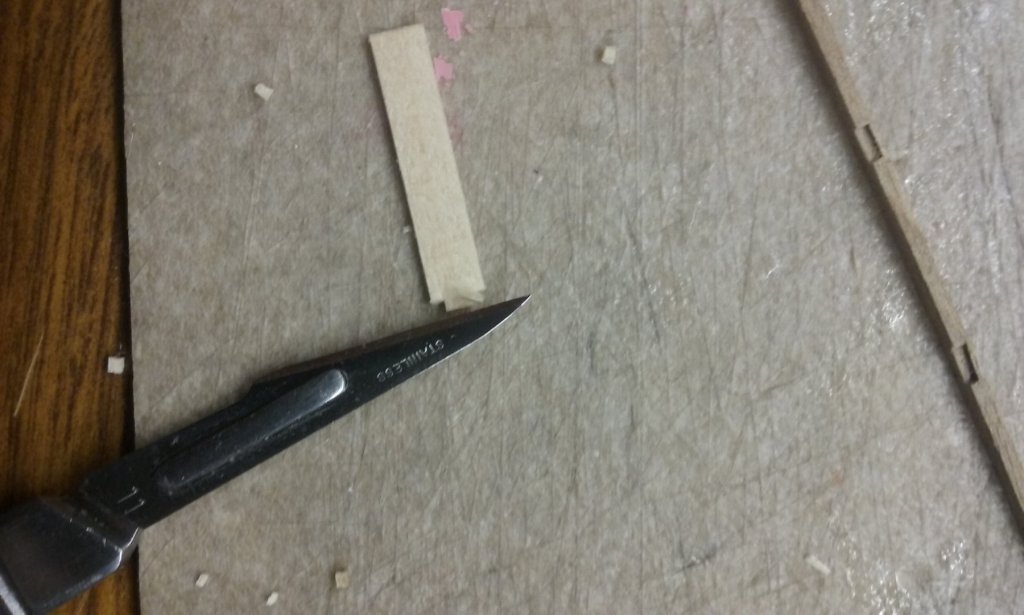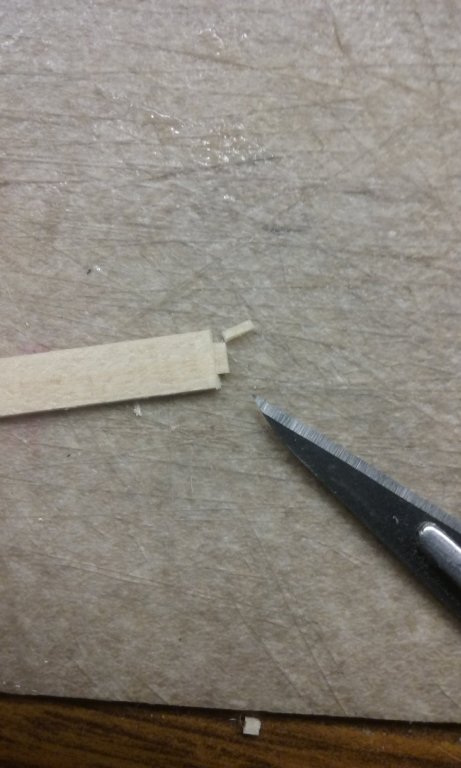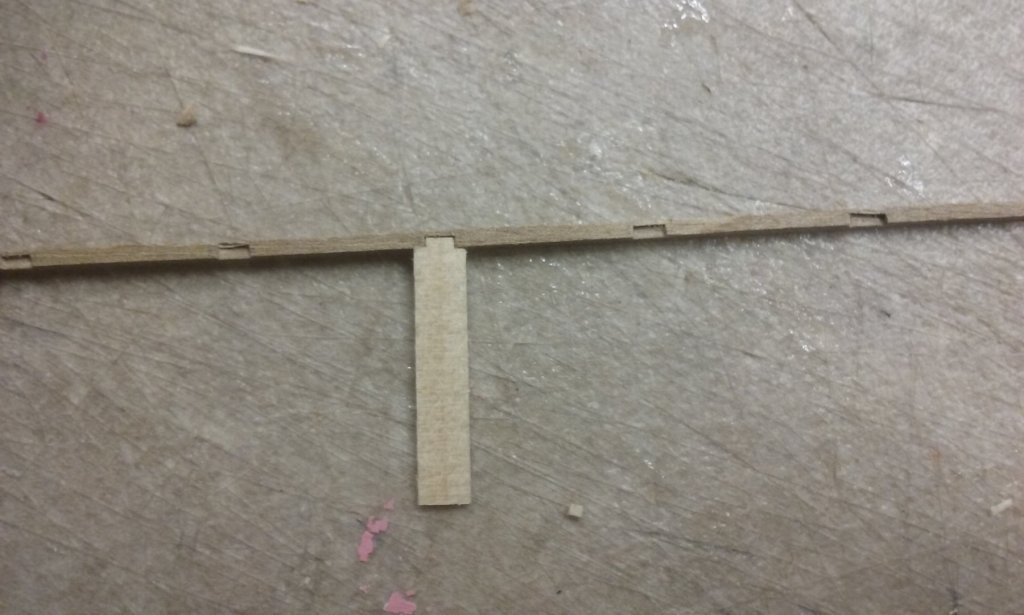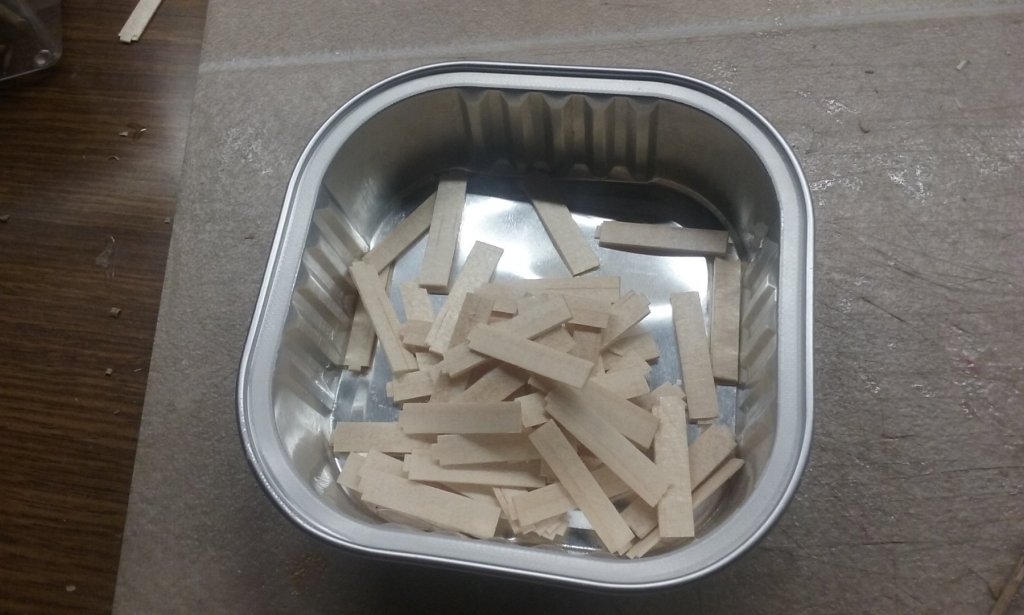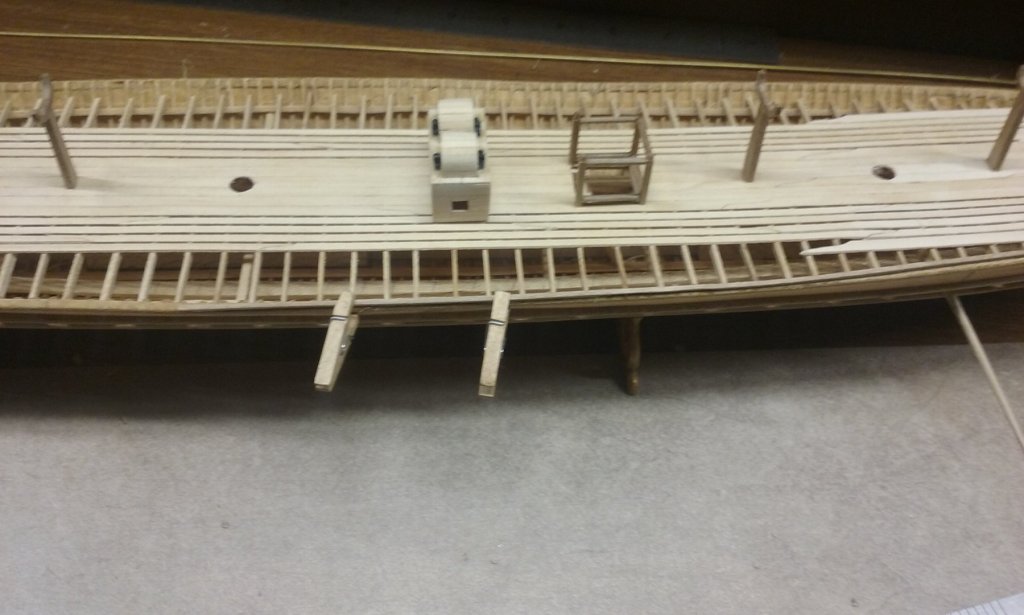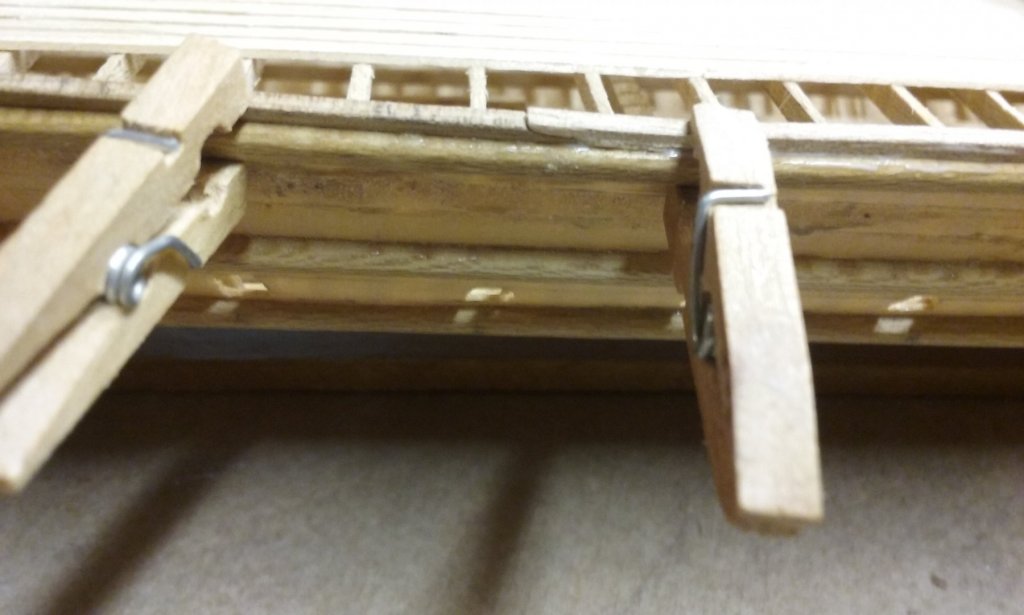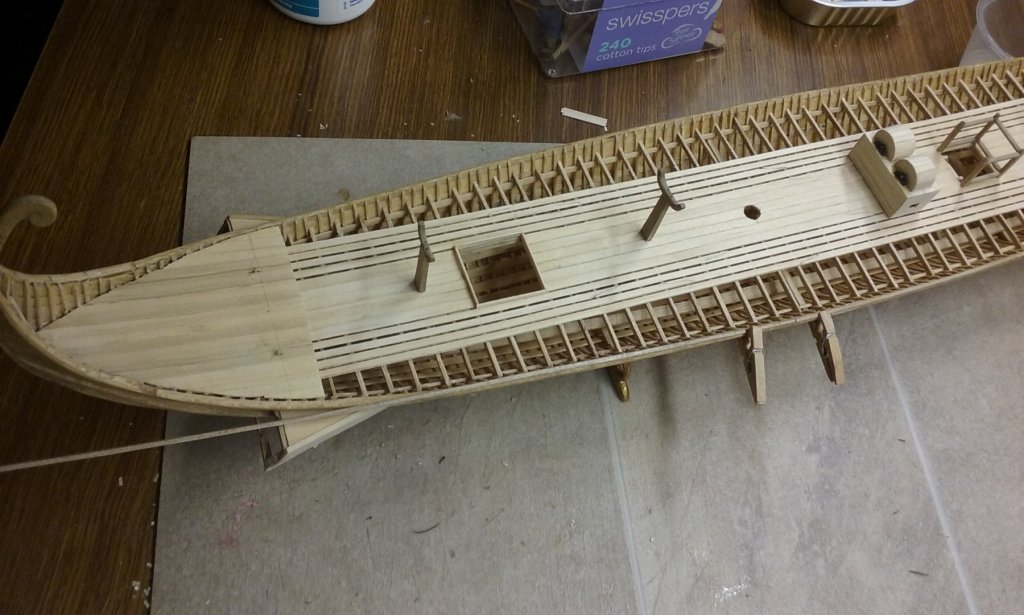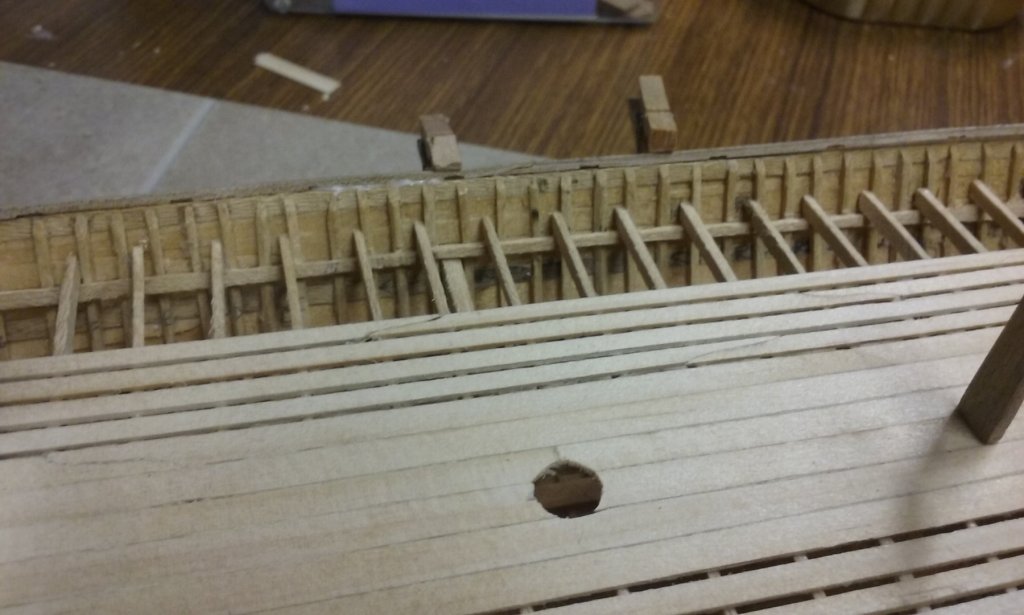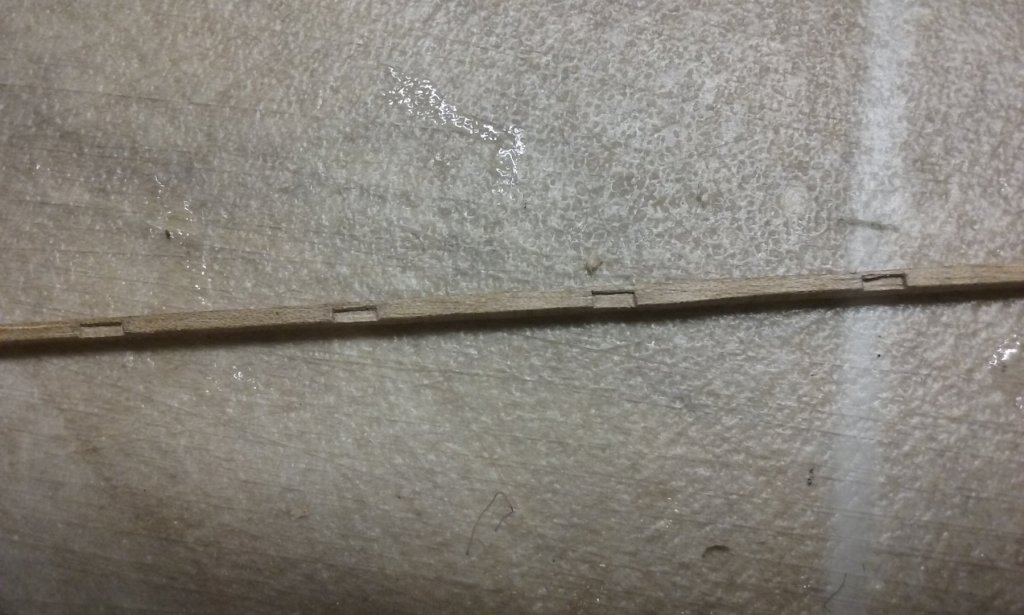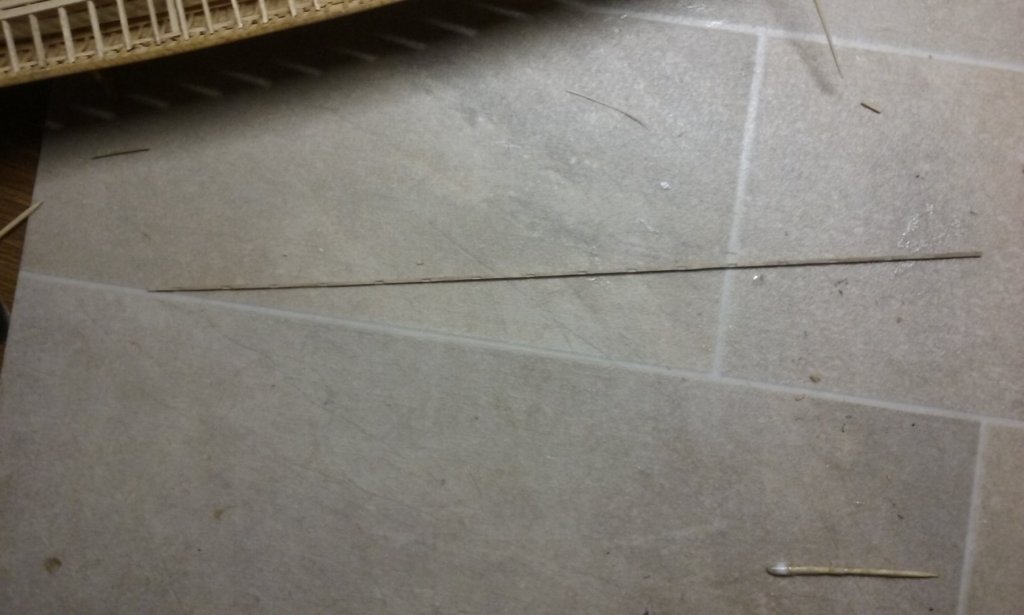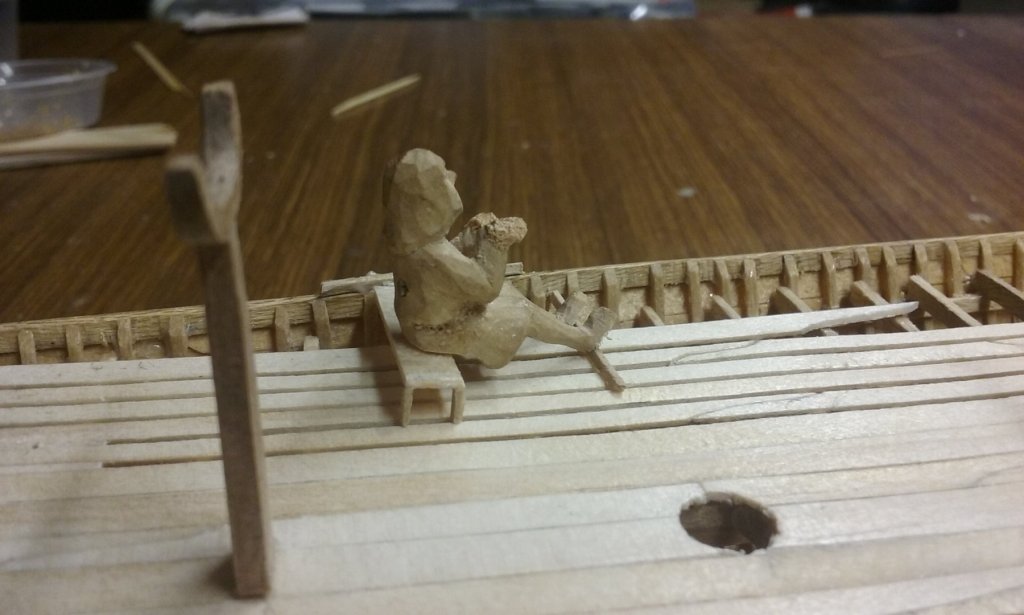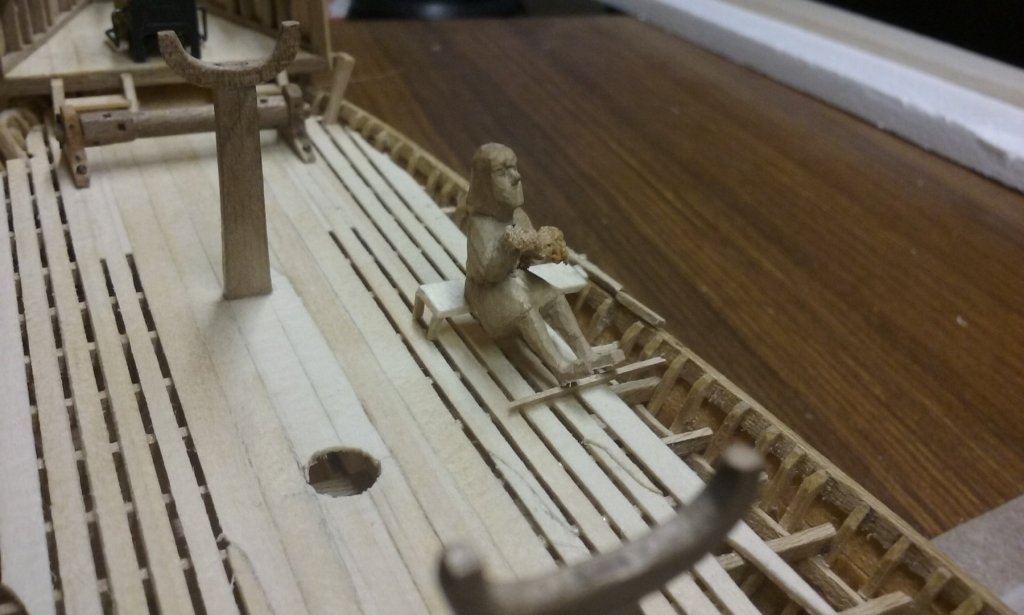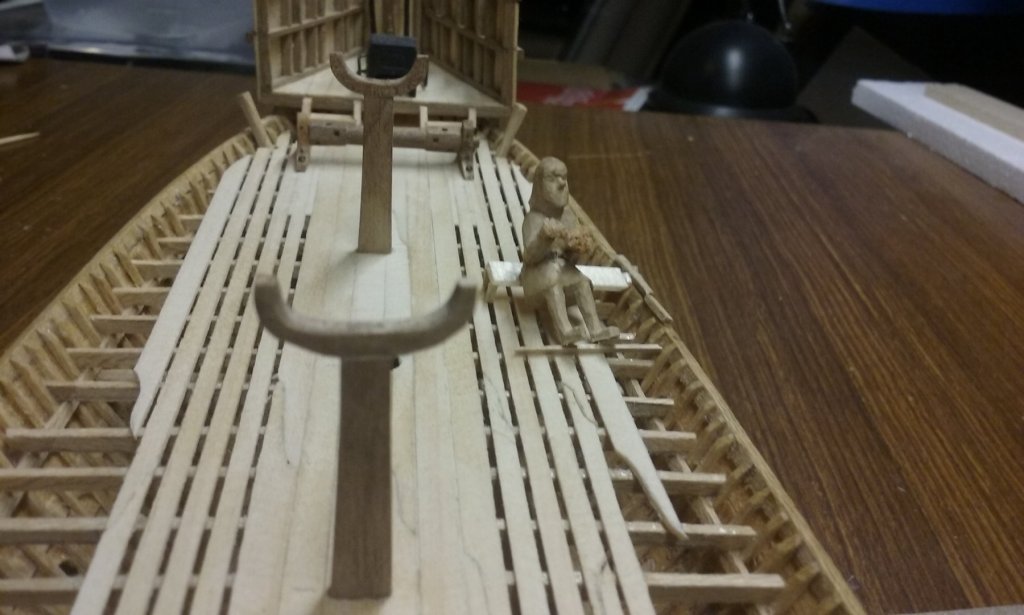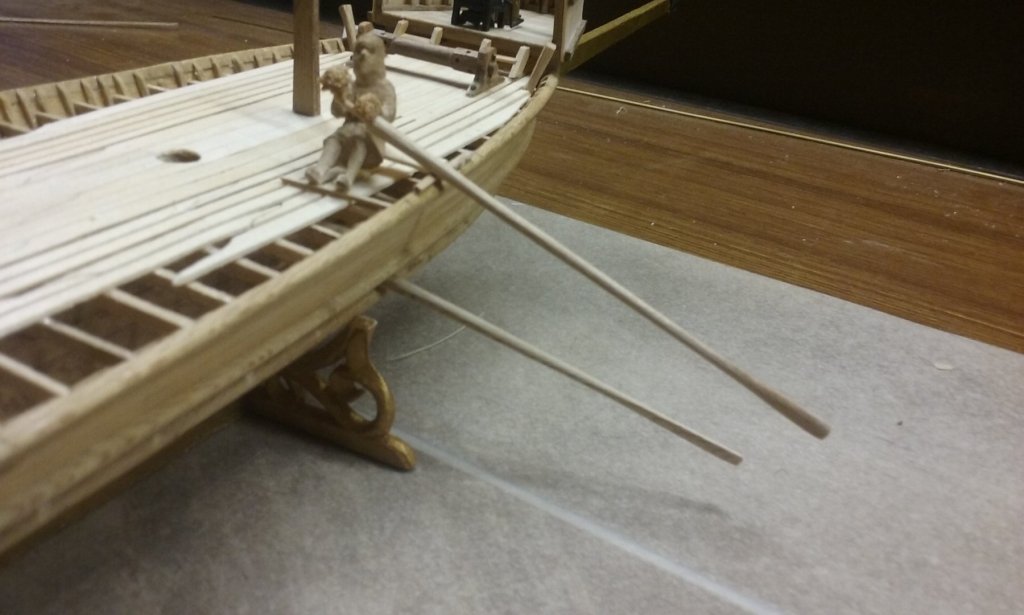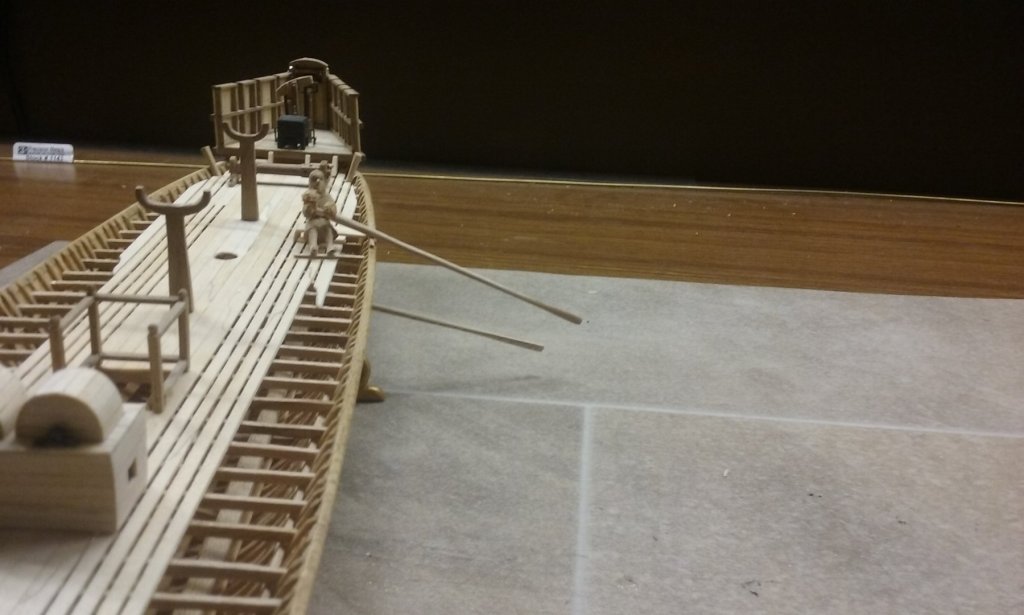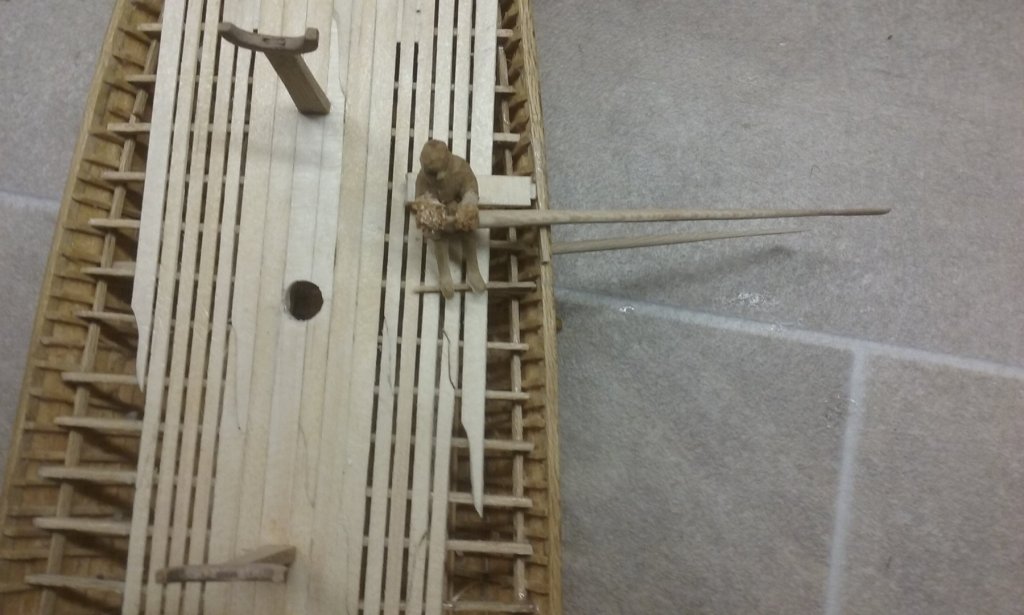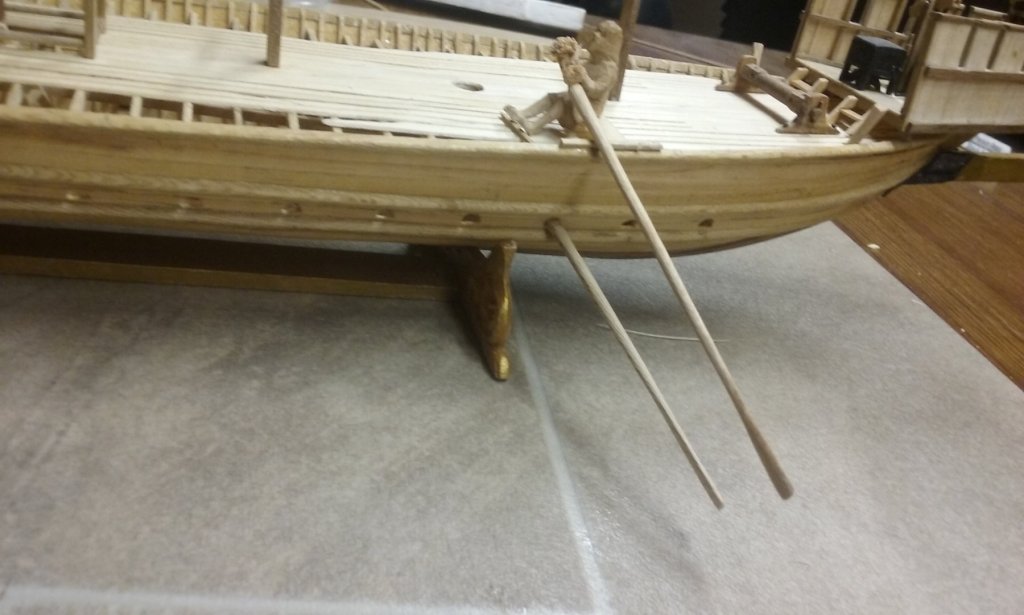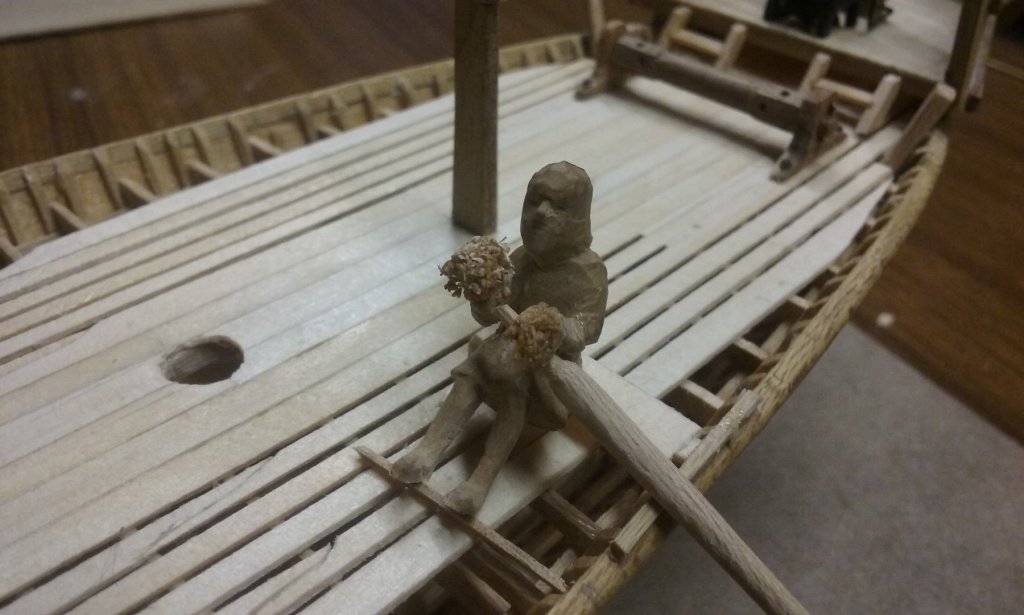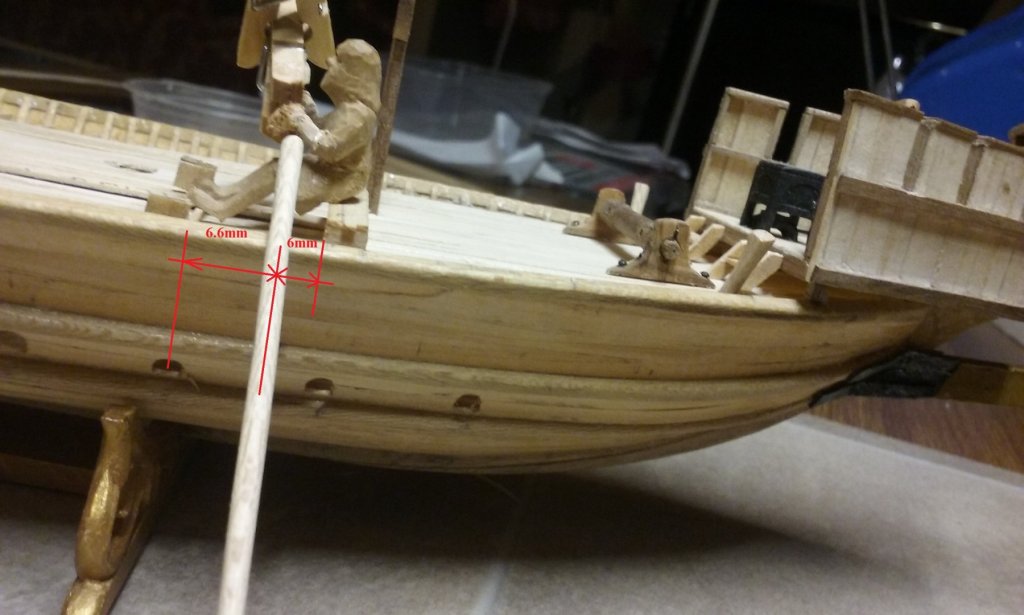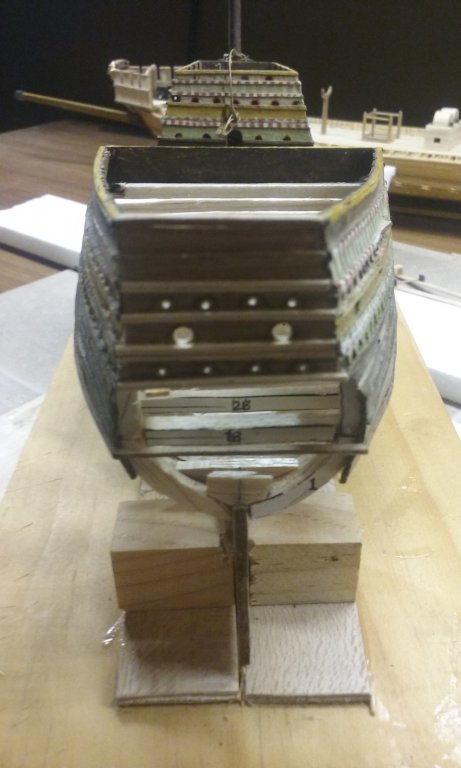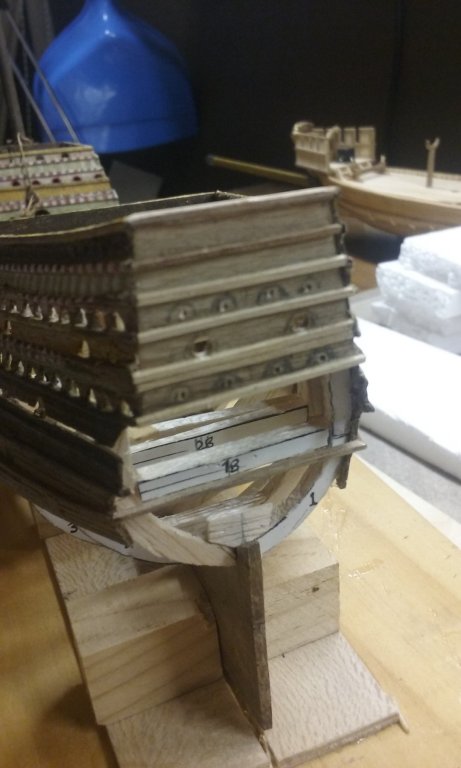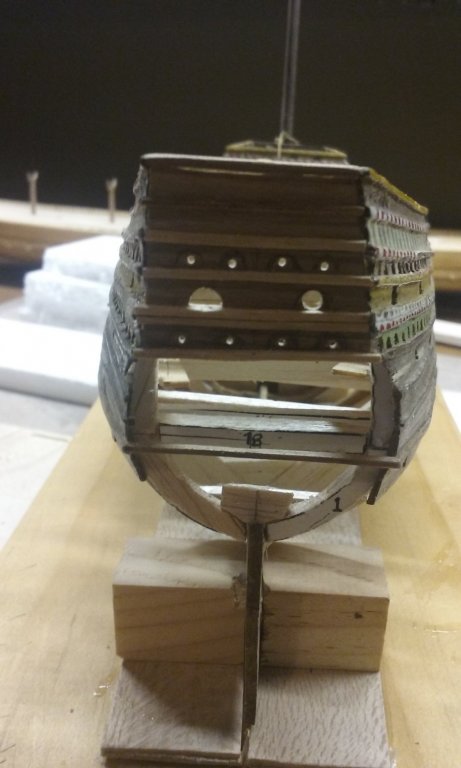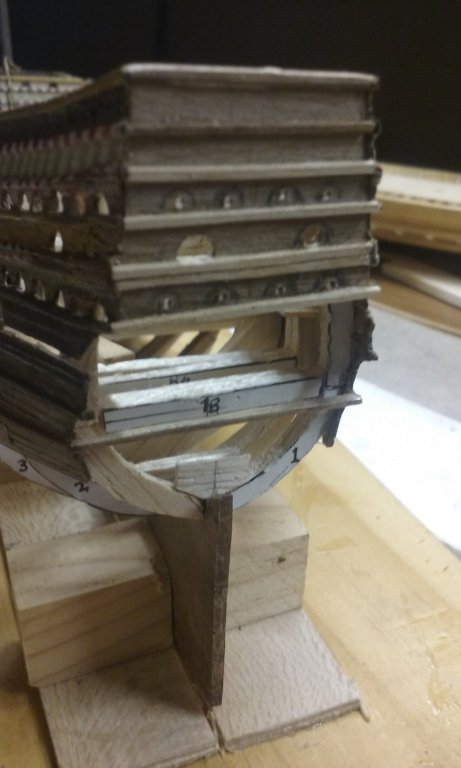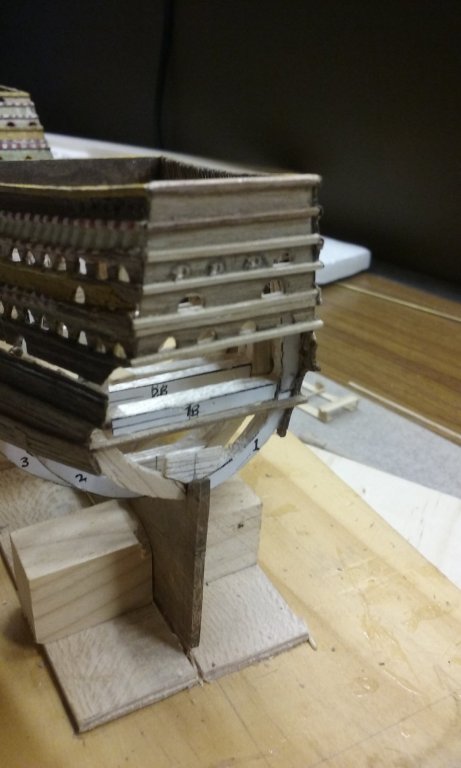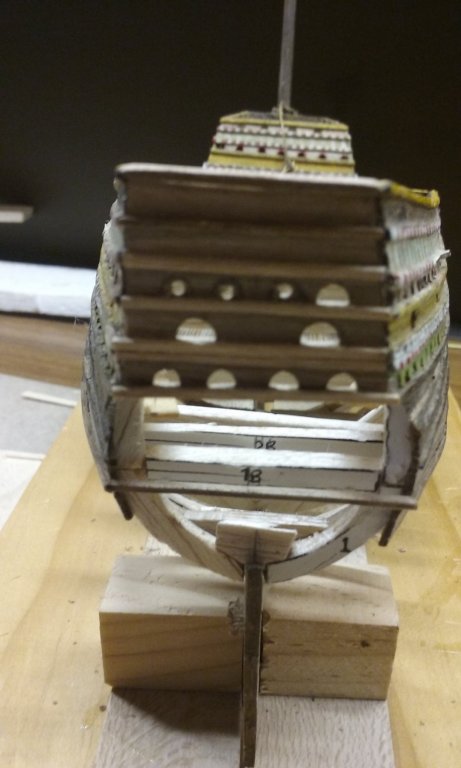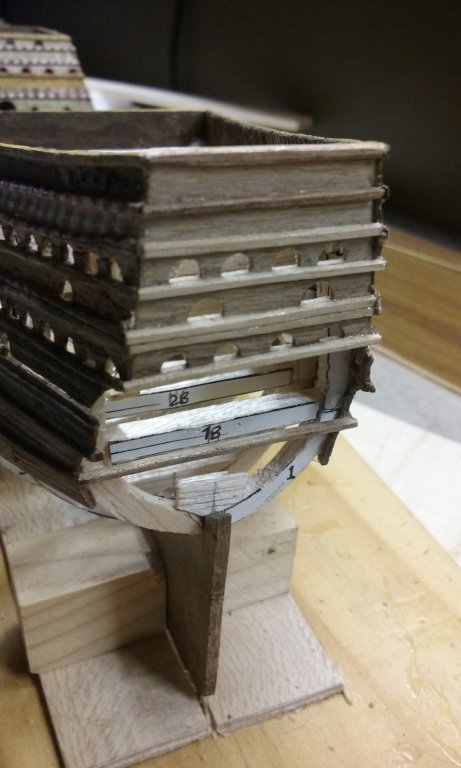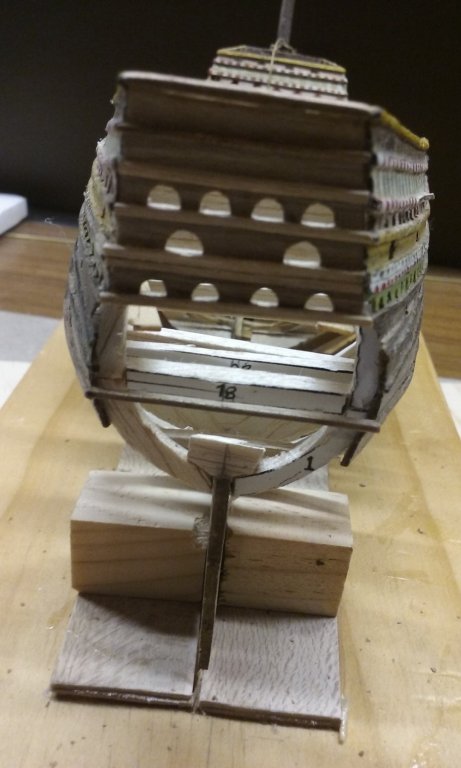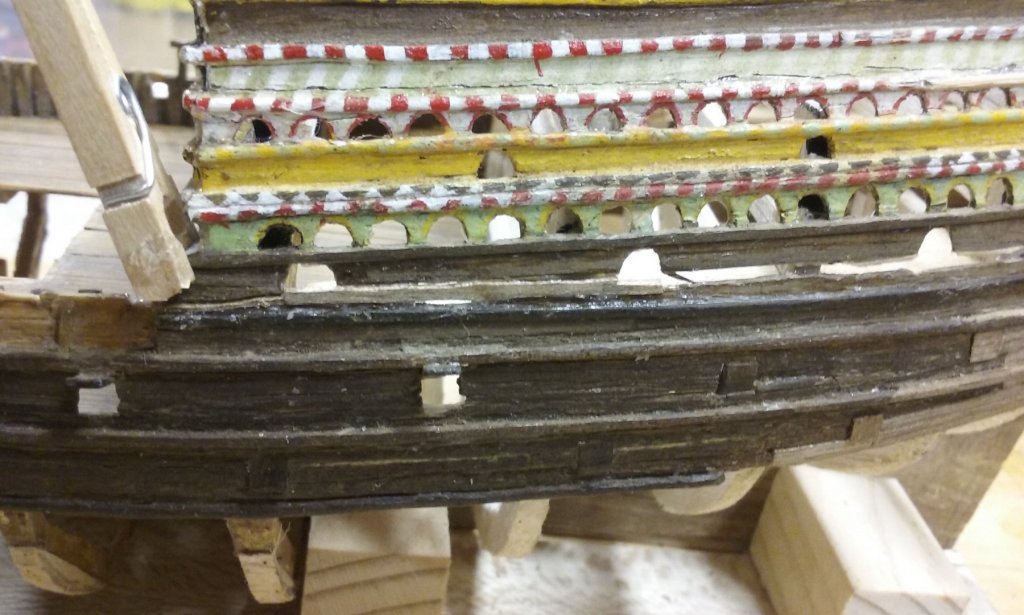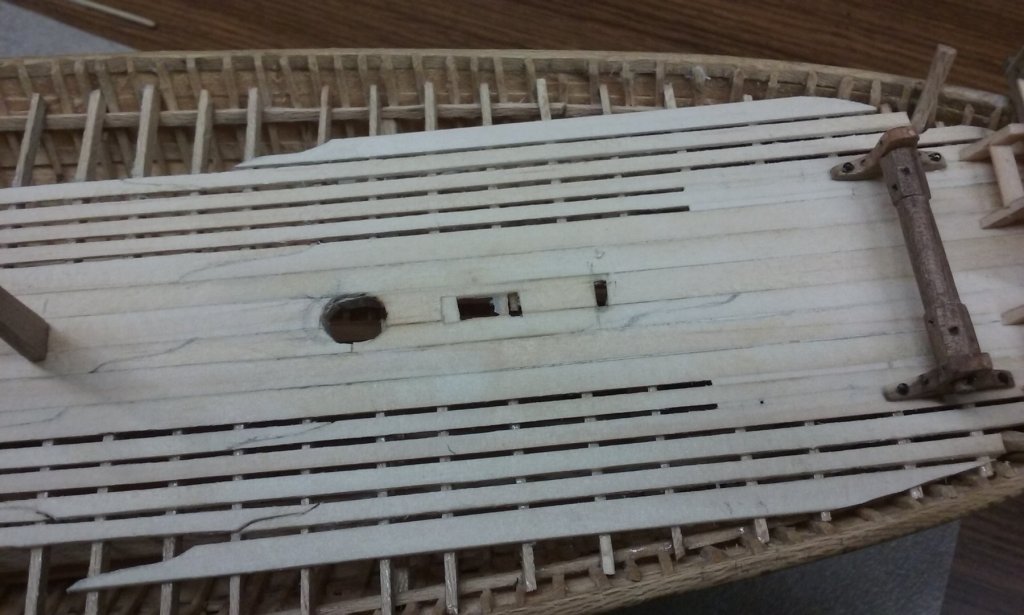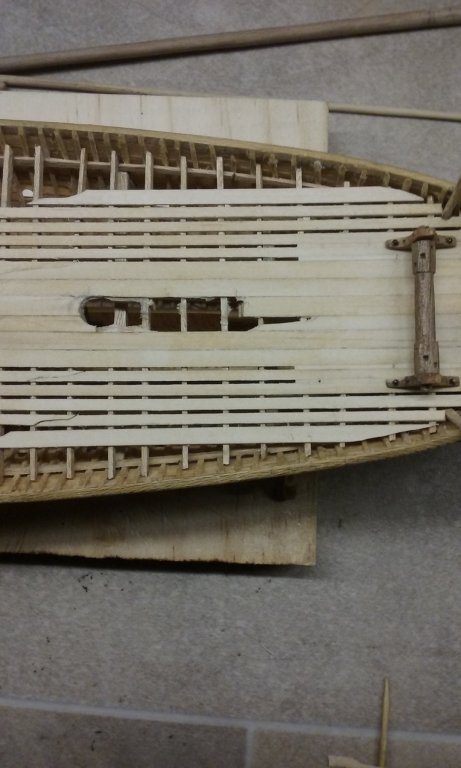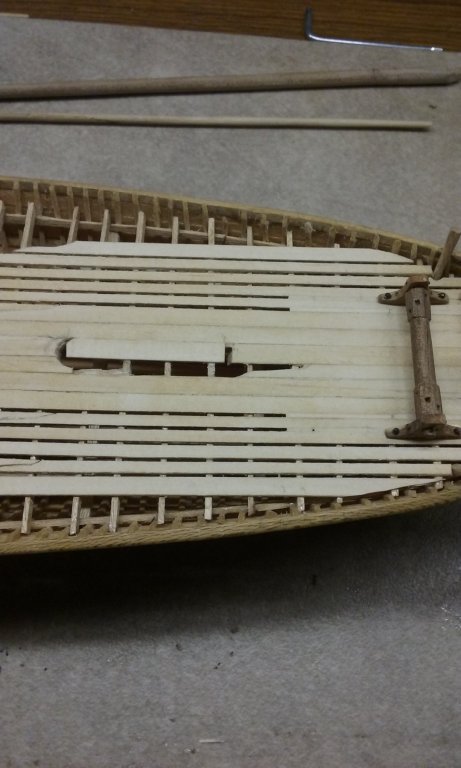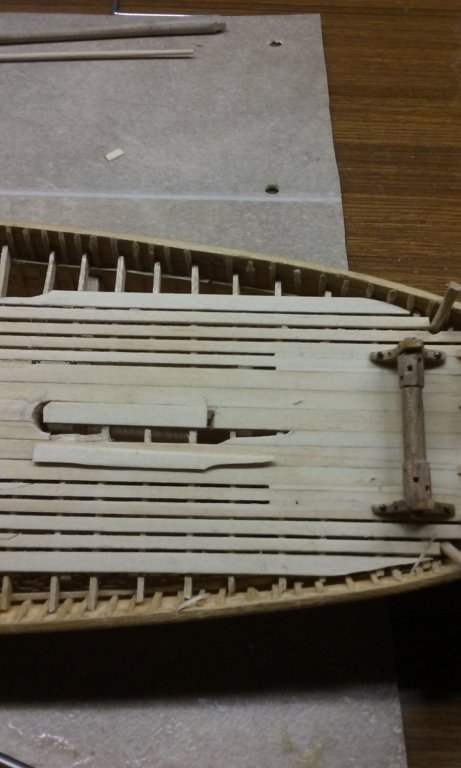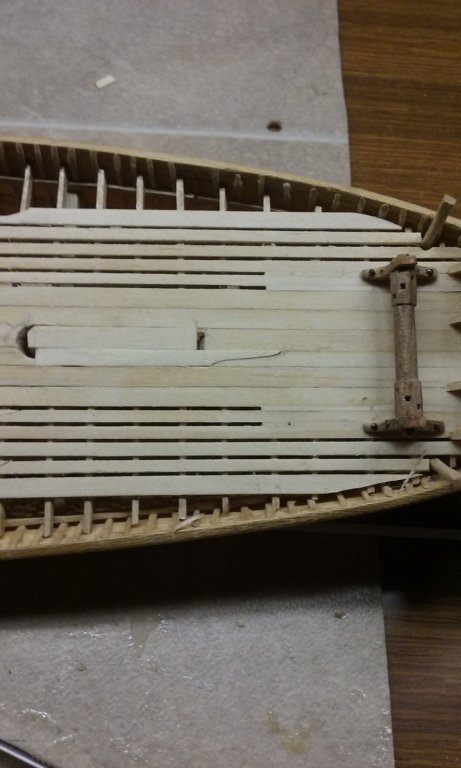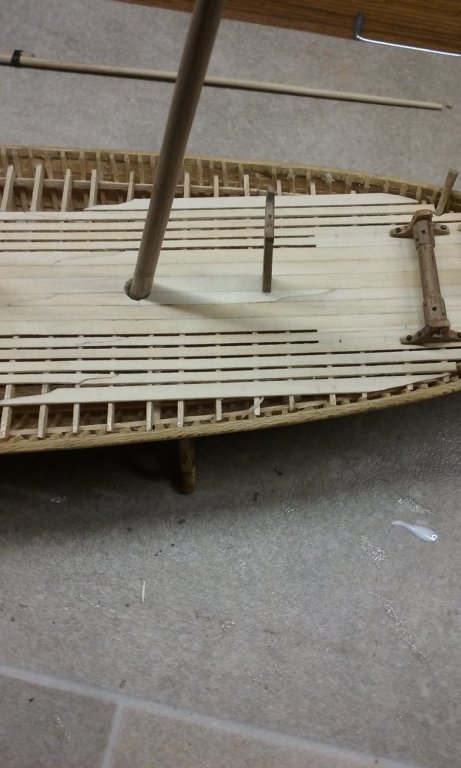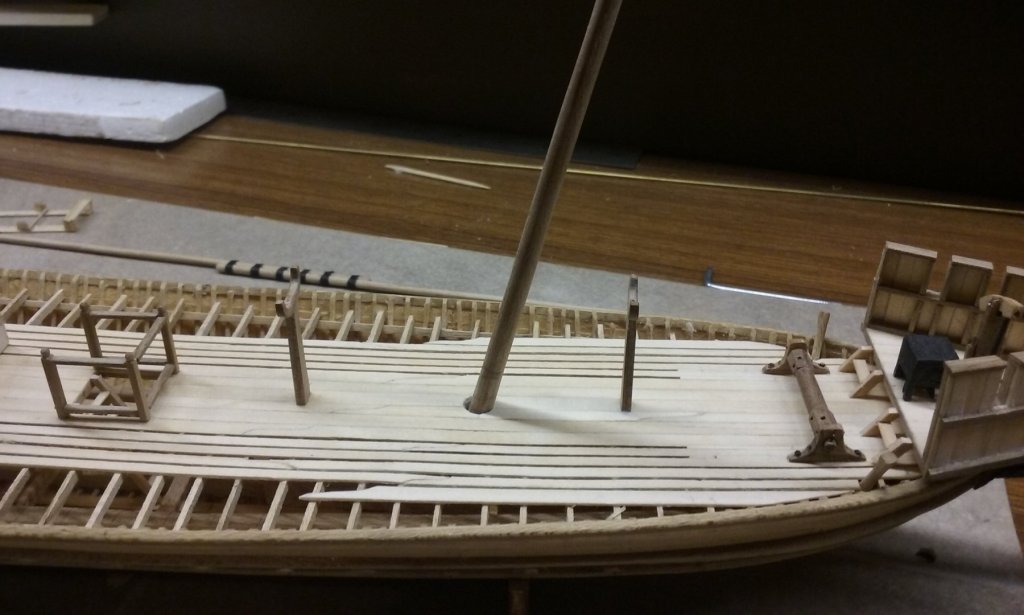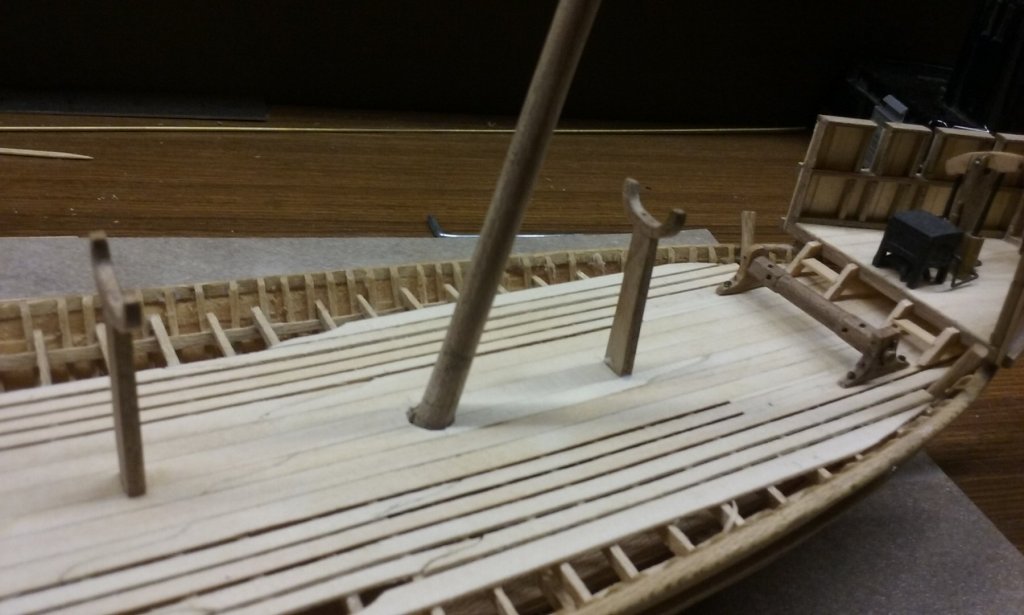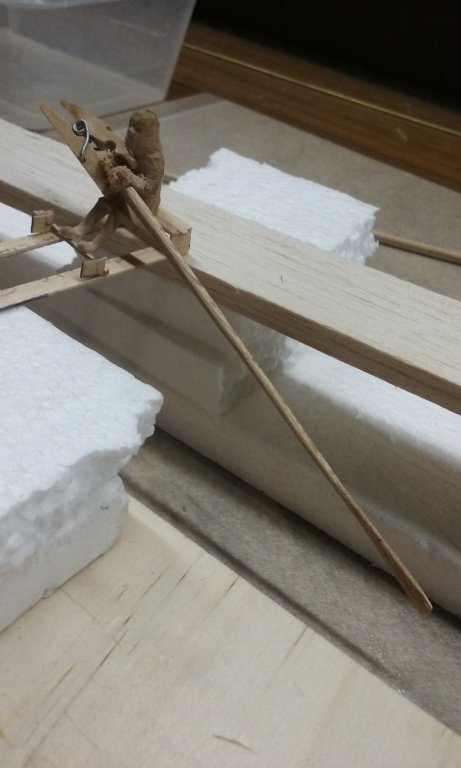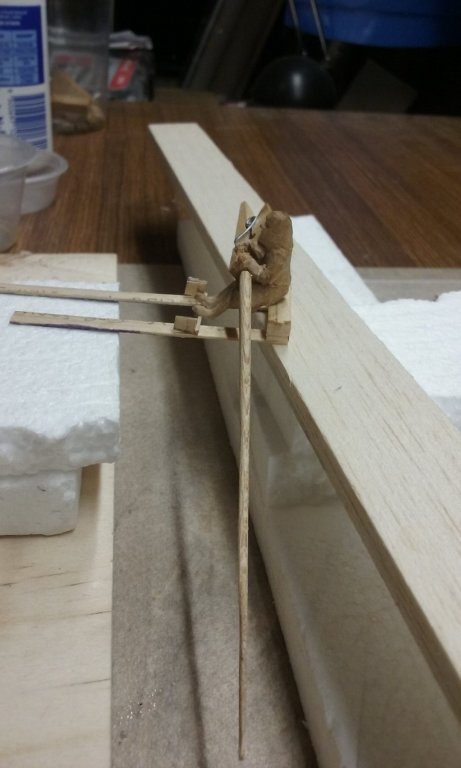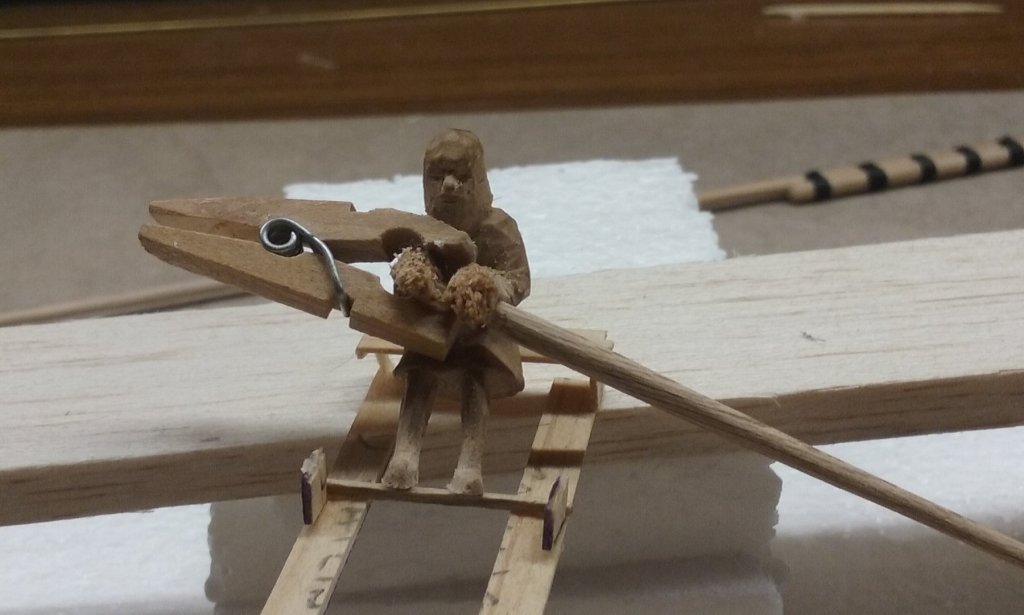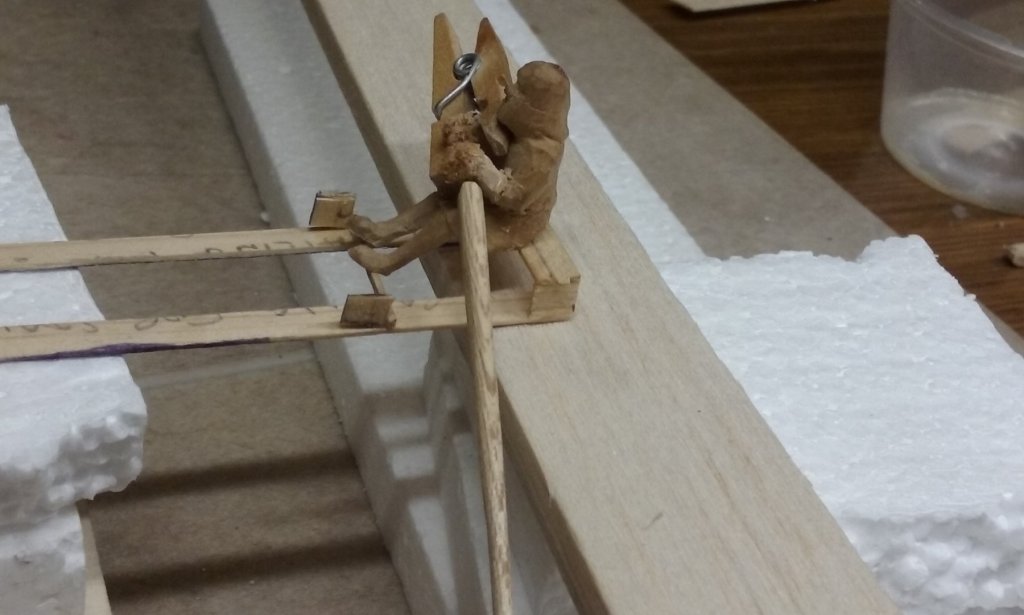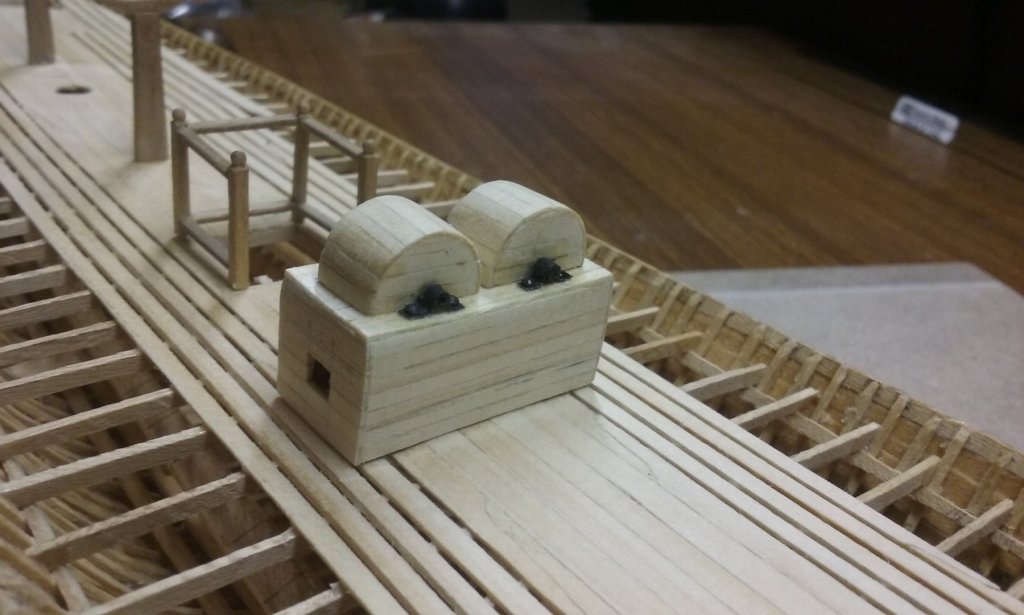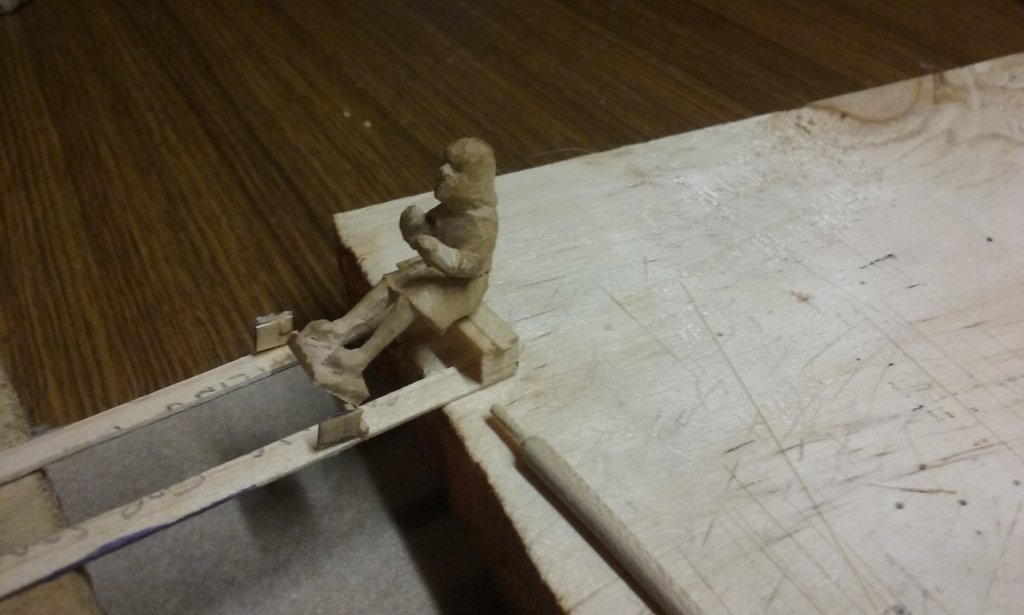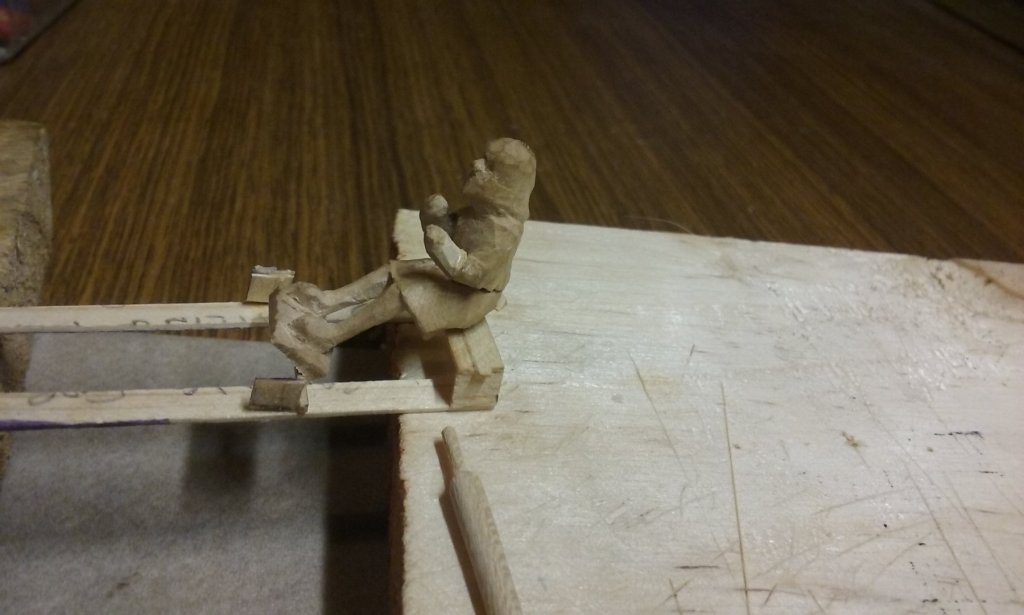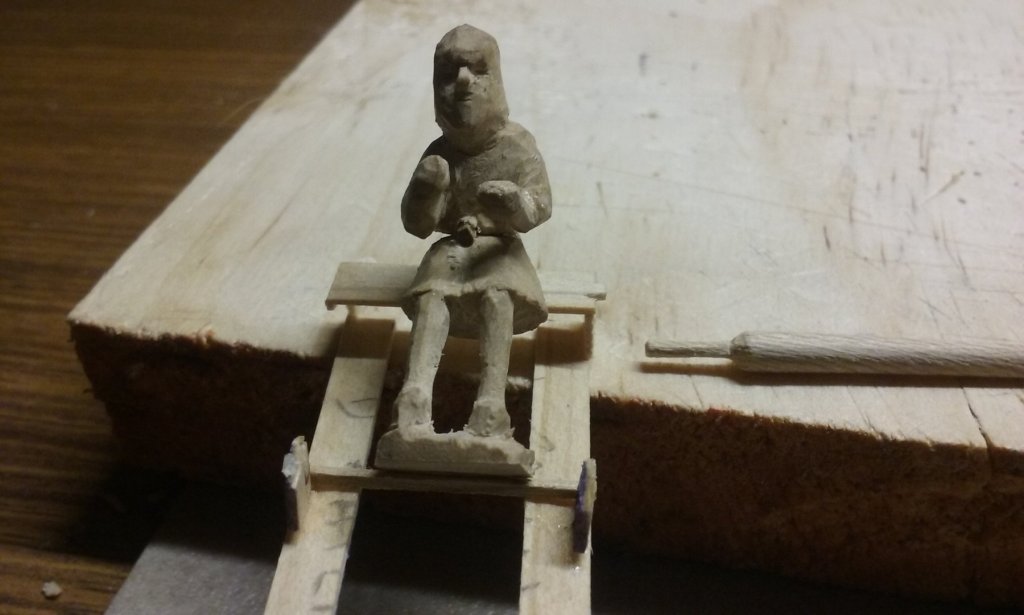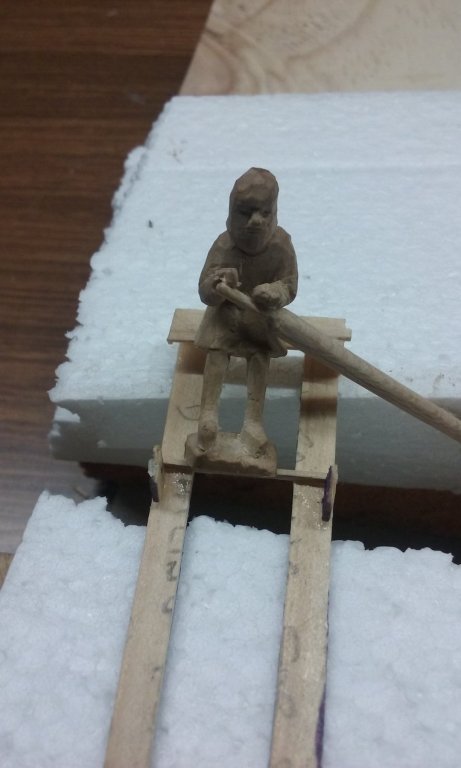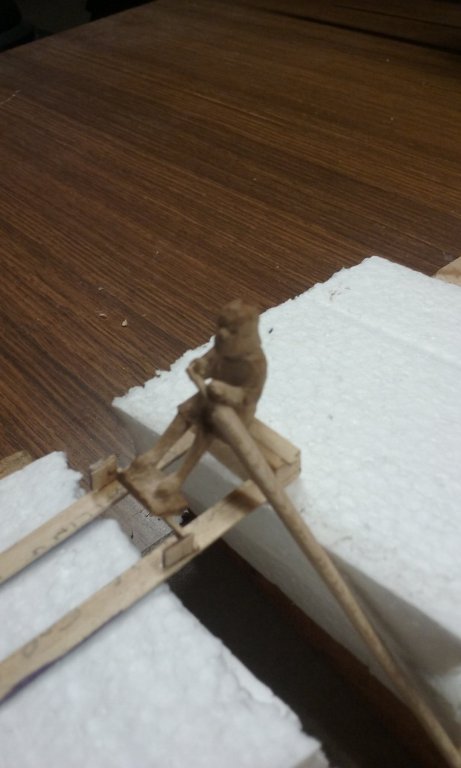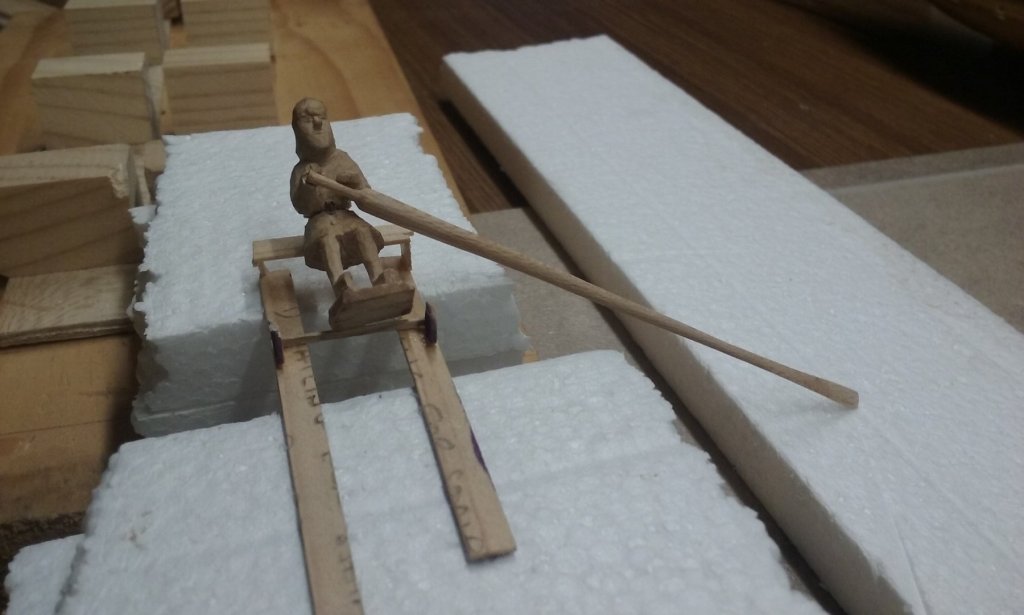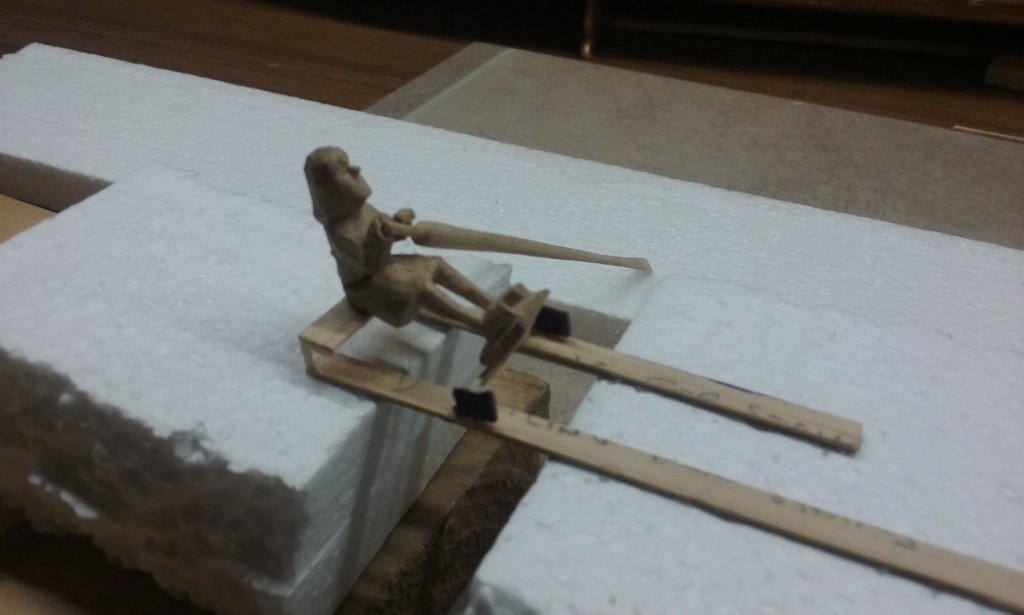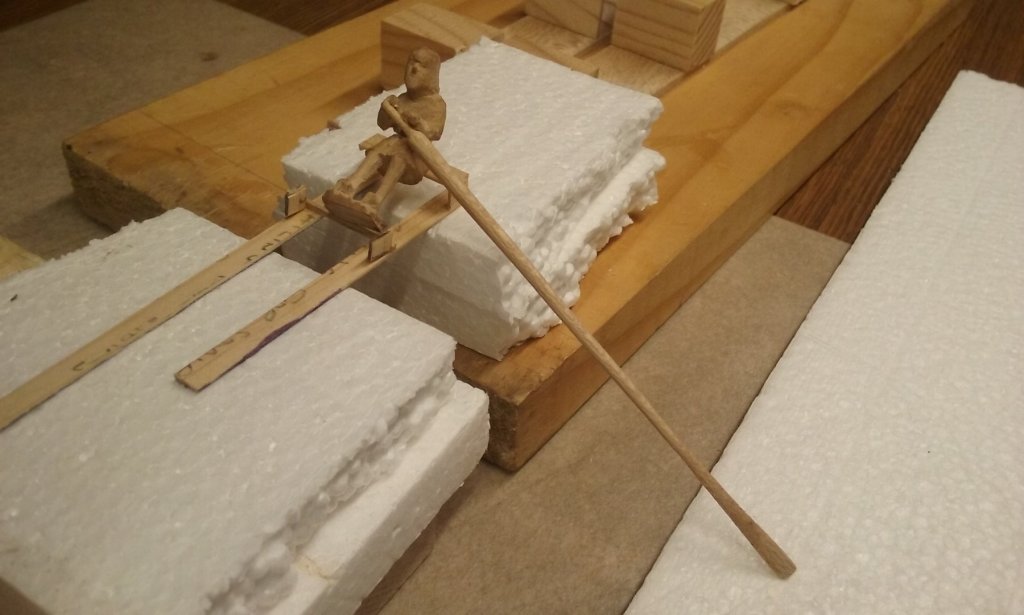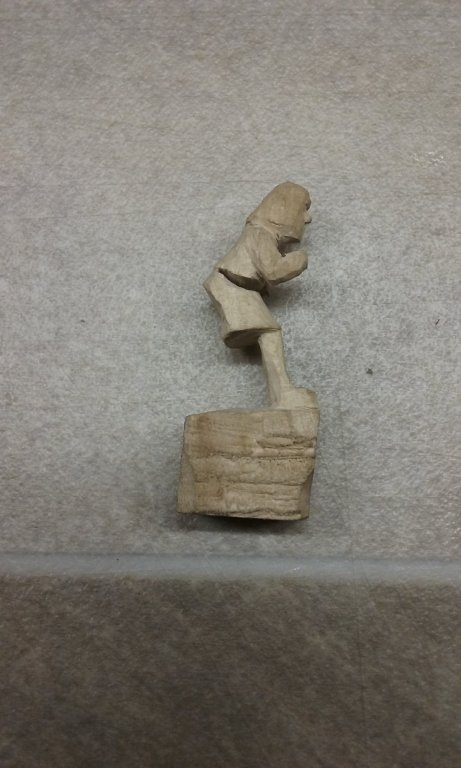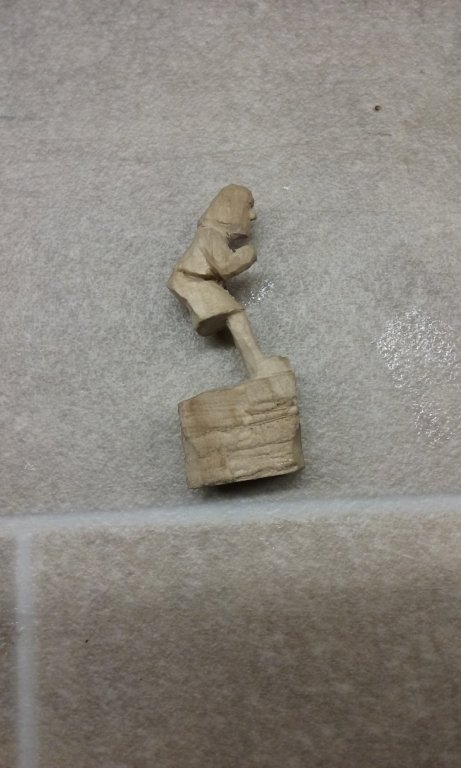-
Posts
7,986 -
Joined
-
Last visited
Content Type
Profiles
Forums
Gallery
Events
Everything posted by Louie da fly
-
That was always a concern, Pat. Certainly I had to ditch a lot more of the old structure than I'd wanted to (have a look at the first couple of posts in this build log). But I've managed to keep much of the original and I'm pretty happy with that. The hull above the waterline will mostly be original, as will the main deck and the forecastle, but the deck of the aftercastle will be new. It's a shame I lost the main hatch and the longboat - they were pretty cool. The bowsprit, fore and main masts and their spars and shrouds I still have, along with their original sails (which will have to be replaced but will serve as a pattern for the new ones). The mizzen and bonaventure mizzen have been lost along the way, along with their spars, sails and rigging, and will have to be re-done. I'm hoping that when it's all done it will be a nice snapshot of what I was capable of at 17, with the new stuff showing how much I've learned in the interim. Steven
- 740 replies
-
- Tudor
- restoration
-
(and 4 more)
Tagged with:
-
I've been carving the prototype for the upper oarsmen for the port side, so I can then cast 25 of them in resin. The starboard one was done some time ago, and I've applied to this one what I learnt from carving him and fitting him to the hull (see post of Aug 15 above), to make a "mirror image". Still in progress. I haven't done the legs properly yet, but coming along nicely. Here are the two oarsmen facing each other - the existing starboard oarsman is on the right. Rather difficult to carve, particularly getting the scalpel blade into the space between the arms and the head and chest to get rid of the "negative space" there. So difficult that I managed to snap off one of the arms while I was trying to do it. I was about to glue the arm back on, when I suddenly realised - problem solved! I now had room to get the scalpel blade in where it had been so difficult. So I left the arm off and carved the chest and head while I had the chance. Now the starboard oarsman is on the left. Here he is "in rough". I need to smooth him off a fair bit, but he has a face and the main features are in place. And then, while I was working on the legs, I broke off the other arm! But again, this posed an opportunity rather than a problem - I'd been a bit worried I'd carved the hands too far apart (the oar handle is pretty short). So now I have the chance, by slightly swivelling the arms when I glue them back on, to get the hands closer together. It's an ill wind that blows nobody any good (or as Mark Twain said, a clarinet is an ill wind that nobody blows good . . .*) More pics when I've progressed further. Steven *He'd obviously never heard the Mozart clarinet concerto played well . . . or Weber, for that matter.
-
I decided I couldn't live with the off-square stern sneering at me, so I took everything off below the transom and started again. To overcome the problem with the wales on port and starboard sides not lining up, I carved the curves in the port side below the transom so they did. I had to re-align some of the port side wales a bit, too, but it felt good to do it. Her are the pics: I put in new wales on the transom, all parallel to the gunwale and the lowest wale. That gave me a starting point. I had to re-cut two of the lowest line of arched gunports, as they'd followed the (off-square) line of the wale below them. And here I have started planking below the transom. The two cut-out curves of the port side at the stern have been adjusted to line up with those of the starboard side: And the first panel of planking below the transom complete. Here it is from the port side. The lighter-coloured wood is the new stuff. Though I was originally going to colour it the same as the original wood I've decided instead to keep it as it is, to show the new work compared with the old. Steven
- 740 replies
-
- Tudor
- restoration
-
(and 4 more)
Tagged with:
-
Bill, if you want your ship to look like she's been at sea for a long time without opportunity for repair or painting, go for it! I remember when I read "Two Years Before The Mast" they kept the crew busy with maintenance of the ship every day during the voyage, but when they were going to their home port they repainted, repaired and made the ship look brand spanking new so they could show off when they got home. It was a point of pride. But they didn't paint her until then. Anything that was worn probably wasn't fixed till then either, unless it affected the efficient handling of the ship. Maintenance of hull, masts, spars, cordage and sails would have been done as a matter of course, but "priddying up" seems not to have been done as a routine, so a ship after a few months at sea would probably have looked a bit dull and scruffy. I suppose it would also depend on the captain, but any expense unnecessary to the running of the ship is likely to have taken a back seat. Steven
-
Finished with the "filling piece" on the port side. And added the planking across the stern. Unfortunately the port and starboard sides don't quite line up, so I've had to taper the planks to gradually change the angle of the planking and get it right at the different parts of the stern (and bodge it a bit, such as lining up the upper surface of a wale on one side with the lower surface of the one on the other side). It's a legacy of my 17 year-old self, plus the changes I had to make to incorporate the existing superstructure into the new hull shape. But once it's cut to shape and sanded smooth you have to look pretty carefully to see it. Steven
- 740 replies
-
- Tudor
- restoration
-
(and 4 more)
Tagged with:
-
Thanks everyone for the likes and comments. Messis, that's a cat food container . . . Here's the starboard stringer nearing completion - I had to make it thinner at the end to cope with the extreme curve at the tail. And here's the port stringer attached at the forecastle And further along the hull And here's the scarph joint And the curve at the stern for both stringers Steven
-
I agree, Dick. In fact I think I'll be using your inspiration (i.e. pinching your idea!) for the position and form of the lower halyard blocks for my own dromon. The PDF on the gréement (rigging) of a carrack I found particularly interesting. I hadn't looked at this PDF before and I had no idea they'd recovered so many rigging elements or done all this reconstruction stuff on how they were arranged. Fascinating. Steven
- 263 replies
-
- nave tonda
- round ship
-
(and 2 more)
Tagged with:
-
Dick, I'm sending you a message and attaching a couple of PDFs from the wreck reports - one on rigging and one with the sep de drisse (which is made of three parts, the lowest of which is emplanted on the keel like on a mast step). Trouble is, there's so much information in these reports I've never taken the time to look all the way through them. But in one of these attachments I've just come across a diagram from our old friend Michael of Rhodes being used as source for the calcet. Steven
- 263 replies
-
- nave tonda
- round ship
-
(and 2 more)
Tagged with:
-
Yes, I'm using an on-line French maritime dictionary that could certainly be described as vieux . . . Very useful, but perhaps out of date in some circumstances. Steven
- 263 replies
-
- nave tonda
- round ship
-
(and 2 more)
Tagged with:
-
Funny, when I translated it, it came out as "hoisting boats". There is a word "manutention" in the text which can mean either victualling or handling (that would probably be the "barrels of wine"), but embarcation turns out to mean ships boats. (Who knew?) Steven
- 263 replies
-
- nave tonda
- round ship
-
(and 2 more)
Tagged with:
-
I've been meaning to look up double pulley A 167 from the Lomellina - here it is: "Discovered next to calcet A 162, under the two wheels A 66, double pulley A 167 was found without sheaves, with a cord passing through one of the end holes. It measures 65.6 cm long with a width of 17.2 cm and a thickness of 9.2 cm, and has two sheave-holes, 19.2 and 20.4 com high and 3.6 cm wide. The presence of a hole at each end signifies that it is part of a two-fold tackle, taking two double pulleys; this tackle system is not normally encountered in the rigging of a ship, except for the mainyard lift. It develops a very great force and could have been used to lift heavy weights (this type of tackle was also used for hoisting the boats.) In any case, the absence of sheaves, as in the sep* and the calcet, could indicate that they had been temporarily unrigged." *The sep de drisse is the fixed block in the main deck which takes the main halyard. Steven
- 263 replies
-
- nave tonda
- round ship
-
(and 2 more)
Tagged with:
-
Probably one of the most difficult planking jobs there is - I had a similar one with my dromon and eventually decided just to leave it as it was and make it an object lesson for next time. Yours is even more difficult because it's clinker, not carvel, so it's harder to disguise slight errors (I've been able to sand mine smooth and I'll be painting over it so it won't be visible). I see that though on the original the stem and sternposts were carved to take the ends of the strakes, they didn't do that on the model. It might have made things a bit easier. The third and fourth strake from the bottom look a little strangely-shaped - the third one seems to taper outwards instead of inwards as it approaches the stem/sternpost, and the fourth has had to be altered to allow for that. There's a similar issue with the third and fourth strake from the top. I don't know if there's a way to completely fix that, however, short of taking off the offending bit and doing it again. Perhaps you could cut the dodgy bits off those strakes and replace them with short planks that are the right shape, each joined to the main strake at a frame. You might be able to fix it with stealers - the Skuldelev site ( https://www2.rgzm.de/navis/ships/ship002/Ship002Engl.htm )says "Part of the sternpost was preserved, and was found with two stealers with carved out continuations of the strakes 2, 3, 4 and 5, 6 respectively. " However, what you decide to do with it is up to you, it's your build and you're the only one who has to be satisfied with it. Steven
-
Here's the starboard stringer with the slots carved out of it. And the forward end glued in place. And the stringer curved and glued in place bit by bit: Here are the upper oarbenches under way: The blank, with a line cut into the end for the beginning of the tenon: Cutting the tenon to shape: And thinning the tenon to fit in the slot: Fifty benches: Scarph joint for the second half of the stringer: More to come . . . Steven
-
Oh, I was prepared to cut the slots in the gunwale, but I have to admit doing it this way will be easier.☺️ Steven
-
Thanks everyone for the likes, and thanks for the comment, Pat. I've worked out how to solve the problem of the gunwale being slightly too low for the bench to be slotted into it - currently with everything at the right height the bench rests on top of the gunwale. So I've decided to put in another, thinner, stringer (I suppose that's the right name) on top of the wale, and I'll be carving slots into the bottom of this stringer, with the top of the gunwale forming the bottom of each slot. I've temporarily added a couple of bits of wood at the top of the gunwale to test this out and it all seems to work ok - you can see them next to the oarsman. I've cut the stringers and I'll add them shortly. I've also been working on the relationship between the lower and upper banks of oars. By rights, at any moment both upper and lower oar blades should be at the same level horizontally (so they're both be in the water at the same time) and the same angle in relation to the axis of the ship (so they don't foul each other). I've pretty much set up the level of the lower oar-blades by putting in a frame below decks to glue them to, so as a preliminary I've glued in my first lower oar. And I've set the lower oar's angle to the axis to follow that of the upper oars (which is mostly determined by the position of the upper oarsman's hands). Now we get into the fine adjustment; until now I couldn't predict where the upper oar blades would end up in relation to the lower ones. it turns out the angle of the "test" upper oar is too shallow, so its blade has ended up higher than that of the lower oar. As the levels of the thole and the oarsman's outboard hand are pretty much set, the only way to alter the angle is to raise his inboard hand. So - more filler to build it up higher, and I'll carve it to shape later. I had originally intended to insert the lower oars blade-first from inboard, which is why I left a bunch of planks off the deck. But with all the other stuff up there now, it looks like it will be better to insert them handle-first from outside. So I've had to carve the handle-ends so they'll go through the oarports - 50 of them. Just finished doing that. So I'll soon be putting the lower oars in and gluing them into place. It's been a long time coming, but if I'd put them in earlier there's have been too much chance of accidentally breaking them off as I worked with the other stuff. When I put the upper oarsman in place it was only a temporary measure to work out the angles and heights. I placed him at random without reference to the lower oarports, so I'm going to have to take off again. But that's a fairly minor issue - I still have to make 50 oarbenches, cast 50 oarsmen, put the all benches in position 12.6mm forward of the lower tholes etc etc Steven
-
Thanks for the likes and comments. Carl, there's an old story (Ancient Greek?) about captives having their thumbs cut off so they couldn't hold a weapon but could still be made to pull an oar . Not sure if there's any truth in it . . . I'm working on exactly where to put the upper oarbenches. Pryor's book Age of the Dromon specifies that to avoid fouling between the two banks of oars, the upper oars should be 330mm forward of the lower ones. This translates to 6.6mm at 1:50 scale. But then you have to allow for the horizontal distance between the thole (the oar-pivot at the gunwale) and the front of the oarbench, which is a fairly complicated thing in itself. The thole has to be located in the best position relative to the oarsman to make it comfortable and mechanically efficient to use the oar. I've looked at a fair bit of information on the theory of all this and it's all a bit confusing - and complicated by the fact that modern oared vessels (racing shells) have sliding seats. Looking at vessels with non-sliding seats (whalers, and of course Olympias), there seems to be a fair bit of variation as to what is believed to be the best position. In the long run I decided to approximate as best I could the distances on Olympias, adjusted in accordance with the little guy I've made (also based on Olympias). Based on that, I put the guy on the deck and measured the distance between the thole and the front of the bench. It comes to about 6mm. So, adding that to the 6.6mm specified by Pryor, each upper bench should be 12.6mm forrard of the corresponding lower thole. This has been bugging me for a long time, and it's nice to have sorted it out. The eagle-eyed among you may notice that I'll have to lose the forwardmost upper bench. I'll probably also lose the aftmost one, because the steering oar gets in the way. Part of the learning process. If I did it again, I'd be making the ship longer to take these problems into account. In the original Byzantine galaea found in Istanbul, each bench had a tenon slotted into a mortise in the upper wale. However, it appears that the upper deck on this model might be too high for that and I may have to add another wale above the existing one to take the mortise. I'd been a bit concerned that I might have to do that, but this is also part of the learning process. Had I my time over again, I'd make the upper wale just that little bit higher - it would also have allowed both the forecastle and the poop to be higher as well, which I would have preferred. It would have made distance up to the poop to be more than a single step, and might have allowed me to put the Greek Fire apparatus below the forecastle as described in the contemporary sources. Steven
-
The arched holes in the transom have now been done. I started off drilling holes where they were to go: Then one by one cutting around the holes with a No. 11 scalpel to make them into arches of two different sizes - larger ones for cannon and smaller ones for railing pieces or swivel guns. All done. And I've started filling in the gap between the lower and upper works on the port side of the ship. The lighter colour wood is the new stuff. Steven
- 740 replies
-
- Tudor
- restoration
-
(and 4 more)
Tagged with:
-
Thanks everybody for the likes, and thanks, Mark. Actually he's leaning too far back because that rotten stand is getting in the way. I based him on a lot of photos of upper oarsmen on the Olympias trireme reconstruction, and at the end of their stroke they are hardly leaning backward at all. I only added the stand so the figure would be easier to cast, but I figured that at the moment it was more important to check that his "angle of lean" was correct, so I cut the stand off. I can always replace it or put another one on. Here are some photos of him with the correct posture (oar temporarily dry-fitted with a peg holding it in place). The reason his hands are all fuzzy is that they were a bit too small and in the wrong place so I've added a bit of glue and sawdust filler to make them bigger. I'll tidy this up on the first resin copy I cast - the filler's a bit too hard to work with and get fine detail. The oarblade comes down to about 2 centimetres below deck level, which converts to a metre between the deck and the bottom of the oar. That's probably not quite enough, but I can adjust it down a bit by slightly altering his grip on the oar handle, and it should reach the surface of the "water". I still have to smooth him off somewhat before he's ready for casting, but that's ok - I don't yet have the stuff I need to do it anyway. And I've finally had an idea of how to align the level of the oarblades with water level without having a surface that stops the blades reaching far enough down. Instead of a flat surface to stand in the place of water level, I can use a relatively open wire mesh, which will allow the blades to go through the holes to the correct level. (Don't know if that all makes sense, but it'll be easier to understand when I post photos - in the fullness of time; I'm not yet ready to do that.) And I've been thinking about a comment Woodrat made about the possibility that the forrard crutch for the yards might foul lower end of the foreyard when it is moved from one side to the other as the ship tacks. I've slightly reduced the rake of the foremast and moved the crutch forrard a bit. I've had to remove parts of two planks to repair the change, but I'd been unhappy with that part of the deck anyway because I'd had a patch in it where I'd already moved the crutch. Hole for the mast elongated aftwards enabling me to reduce the rake, and starting to remove the planking. You can see the patch in the deck just forrard of the mast opening, the slot for the old crutch position and the new slot furthest forrard: Planking all gone and a scarph joint cut in one of the remaining planks First new plank cut and being shaped to fit the gap. (I've cheated by putting a concealed joint in the planking below the relocated crutch). First new plank in place and second plank shaped and ready to insert. Second plank glued in place. Mast-hole cut in new planks, mast dry fitted, and relocated crutch glued in place. Voila! So it's now all tidied up and fouling should not be a problem any more (not that I'm going to be doing it in the real world - this is in what you might call "model space" (in-joke for people familiar with AutoCad). Progress slow but steady. Steven
-
Thanks for the likes and the comments. Funny, I'm in the middle of reading a book called "Finders Keepers" by Craig Childs about archaeological looting, (which is a major problem and is nowadays carried out on an almost industrial scale) - the thing that grabbed my attention though, was his statement "I have secretly wished to be an archaeologist myself, but I do not have the patience for the scientific tedium involved, which would test model-ship builders." (my italics). Nice to see the recognition of one of the main qualities of a ship modeller . . . Maybe I'll make this my signature? Steven
- 740 replies
-
- Tudor
- restoration
-
(and 4 more)
Tagged with:
-
Painted the metal brackets on the chain pump and cut the holes for the lands. I still have to put an edging around the holes. Here's the little guy on a mock-up of the rowing bench, with his feet resting on a bar at the back of the next bench. He's still leaning back a bit too much because the stand under his feet is in the way, but I have to keep that because it's needed in the casting process. If you're wondering what's sticking out of his tummy in the third photo, that's a wooden pin I used to hold him together while I was gluing him together at the waist to sit further forward. I only just noticed it, and I've now carved it off. And here he is with an oar in his hand, held in place temporarily with a dab of PVA glue. The angle's pretty good but I'll need to extend his fingers a bit to curl around the oar handle better. From what I've learnt making this guy I'll be able to do the starboard guy better - in particular if I drill a hole for the oar handle before I start shaping his hands it should be easier to get the angle of the oar correct, and the shape of the hands should be easier to do as well. The oar blade is currently facing the wrong way - it should be perpendicular to the water surface. But this is just a test to get the fit right - it will be fixed when the time comes to put everything together. Steven
-
You may be right, Dick. It's a little confusing, and I don't think M. Burlet was very specific with his explanation. Or perhaps it's just my rotten translation. By the way, in the passage above I think "top-rope falls" should be "top-rope downhauls". Nice work on the pumps. Funny to see that the idea of pulling down on a lever with gravity on your side, instead of pulling up against gravity, hadn't yet come into use by this time. But it's confirmed by the 15th century Baltic wreck mic-art posted recently. Steven
- 263 replies
-
- nave tonda
- round ship
-
(and 2 more)
Tagged with:
-
Thanks for the likes, everyone. They may well have been, Carl. I have to admit it never occurred to me, but in any case I had to make a decision. Though it involved a fair bit of work to extract, the Byzantine Empire wasn't short of metal, so I think I can feel justified in using iron. Steven
-
Oh, and here is the carved original I intend to cast in resin for the oarsmen for the port side of the ship. It's quite difficult getting him exactly the right shape and with his hands in the right position so that he can sit on the oarbench with his feet resting at the base of the one behind him, while holding the oar so the blade goes in the water and the angle of his stroke is right. I discovered he was leaning back too far to do all that, so I cut a wedge out of his tummy and glued him back together so he was sitting up more. I won't be able to check if he's exactly right till I can cast a copy of him and put it in position. A lot of trial and error involved. And though I had made a starboard side oarsman in wax, I wasn't happy with him and I'm going to do him again in wood (which I feel more comfortable with, and which is rather more forgiving). Steven
About us
Modelshipworld - Advancing Ship Modeling through Research
SSL Secured
Your security is important for us so this Website is SSL-Secured
NRG Mailing Address
Nautical Research Guild
237 South Lincoln Street
Westmont IL, 60559-1917
Model Ship World ® and the MSW logo are Registered Trademarks, and belong to the Nautical Research Guild (United States Patent and Trademark Office: No. 6,929,264 & No. 6,929,274, registered Dec. 20, 2022)
Helpful Links
About the NRG
If you enjoy building ship models that are historically accurate as well as beautiful, then The Nautical Research Guild (NRG) is just right for you.
The Guild is a non-profit educational organization whose mission is to “Advance Ship Modeling Through Research”. We provide support to our members in their efforts to raise the quality of their model ships.
The Nautical Research Guild has published our world-renowned quarterly magazine, The Nautical Research Journal, since 1955. The pages of the Journal are full of articles by accomplished ship modelers who show you how they create those exquisite details on their models, and by maritime historians who show you the correct details to build. The Journal is available in both print and digital editions. Go to the NRG web site (www.thenrg.org) to download a complimentary digital copy of the Journal. The NRG also publishes plan sets, books and compilations of back issues of the Journal and the former Ships in Scale and Model Ship Builder magazines.




